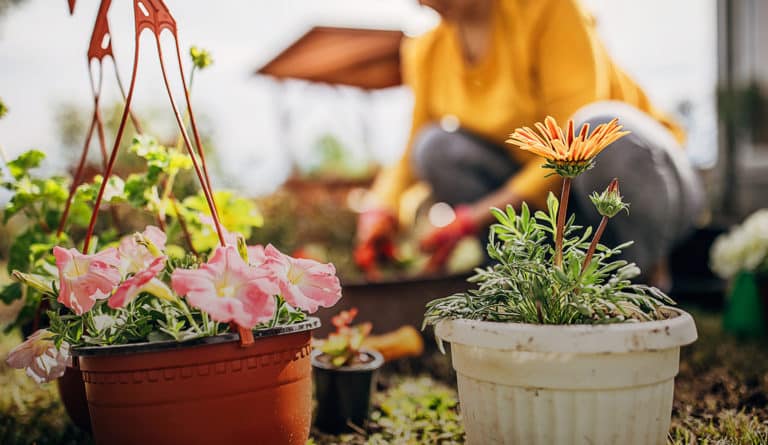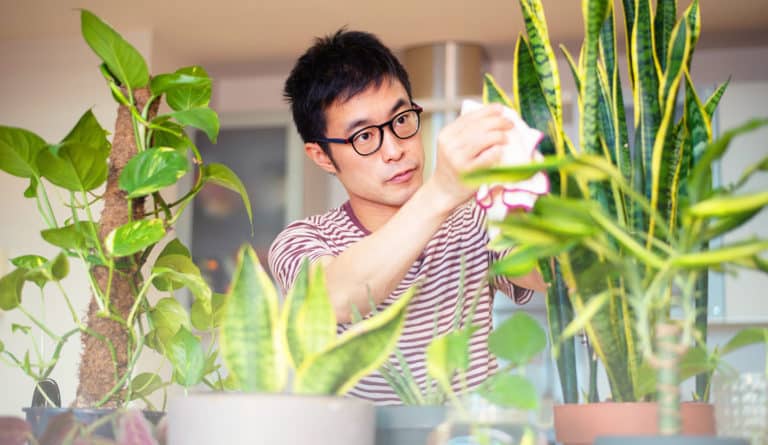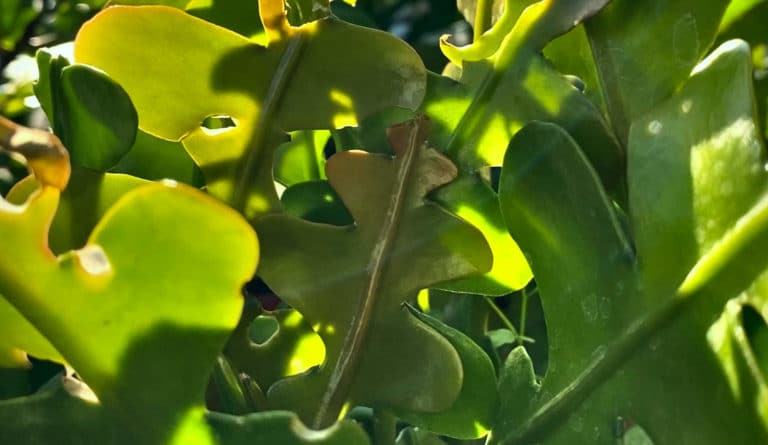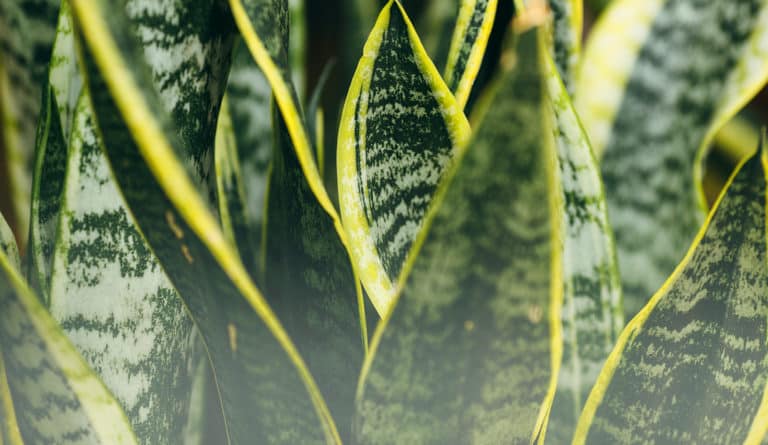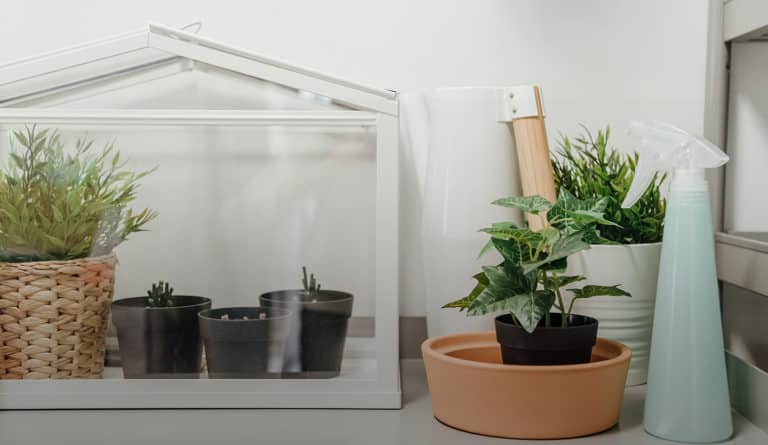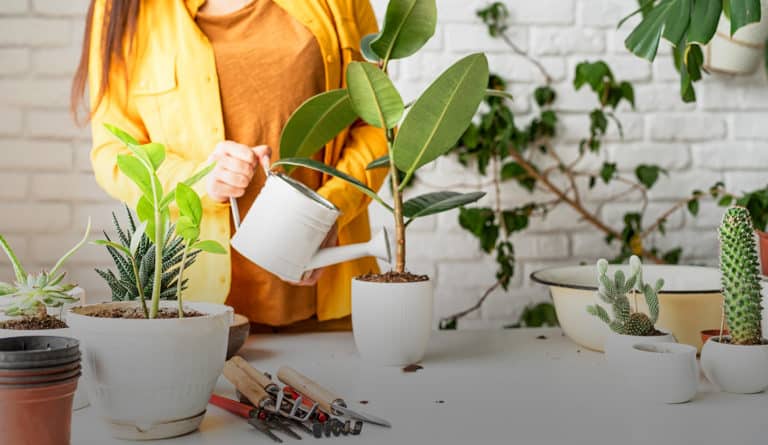- 24” x 48” Good one-side plywood (For 30 propagation stations)
- Tape measure
Straight edge/ruler
Speed square - Painters tape
- Protractor or comparable tool for measuring angles
- Pencil / Eraser
- Test Tubes (20x150mm) Linked here!
- Stain of your choice
- Polyurethane (Optional)
- Mitre saw
- Table saw
- Table saw push tool
- Power drill
- ¾” Spade bit
- Jig saw
- 4” (10) Wood jig saw blade
- Clamps
- String (colour of your choice, I used hemp)
- Yarn needle
- Clear double-sided tape
- Sandpaper
- Electric sander
- Ear protection
- Safety glasses/goggles
- Mask
- Command hooks / Hanging nails
Hello all! I’m Shavonne and I’m back on Plant Project Canada’s page to teach you how to create these beautiful plant propagation stations. This was one of my first-ever woodworking projects and I’m so glad to be able to offer you the highly requested plans to make them yourself! One sheet of 24” x 48” Plywood should make around 30 propagation stations so you’ll have plenty to gift to your favourite people or make an incredible plant wall for your home.
Have you checked out our other projects on Plant Project Canada’s blog? Click the links to the project plans and videos here:
- Garden Planters with Blooming Archway (Article)
- Garden Planters Video
- Light-up Living Plant Wall (Article)
- Light-up Plant Wall Video– Outdoor Holiday Arrangements (Article)
- Outdoor Holiday Arrangement Video
My social channels are Once Upon a Bungalow, and you can find me on Instagram, Facebook, TikTok, and YouTube. We are always up to something in our little bungalow, so please come and join the fun. I am looking forward to seeing you there! Alright, Let’s get building…




step 1.
Start with a 24” x 48” sheet of good one-side plywood. Mark 8” upwards from the 48” side and use a pencil and a straight edge to draw a line. Continue this to make three lines, all measuring 8” wide. Using a table saw, make three cuts lengthwise along the wood. This will create three strips of 8” x 48” plywood. There will be a few inches extra, discard this, as it’s not needed for this project. Refer to the images below.



step 2.
These propagation stations are cut at a 60-degree angle. This makes each side of the triangle exactly 8 equal inches. Using a protractor (or tool of preference to find an angle), mark the triangle lines at a 60-degree angle. Only measure this angle for one triangle, then use the first triangle as a template for the rest of the propagation stations.
Cut the first triangle using a mitre saw at the exact angle marked on the wood. Flip the wood over, and use the triangle that was just cut to mark the next triangle. This way, there will be no waste and no adjustments to make on the angle of the mitre saw. Continue to flip the wood, mark the angle, cut, flip, mark, and cut! There will be 30, 8” x 8” x 8” triangles. Refer to the images below.



step 3.
Estimate the center of the triangle and place painter’s tape on the front and back of the propagation station. The use of painter’s tape is important for a nice clean cut on plywood. Find the center by placing the speed square in line with the bottom point of the triangle. The center point should be around 4” in the middle of the triangle, but it’s best to measure up from the bottom to find the center.
Using a speed square mark the center point of the triangle with a pencil. Once the center is marked, use a tape measure to mark a ¾” spot for the test tube to fit snuggly into. To make the ¾” spot, measure from the centerline ⅜ of an inch out each way.
Next, measure 5” from the top of the propagation station to find the bottom of the test tube spot on that center line and mark this as well. Place the top of the test tube perpendicular to the propagation station, and on top of the 5” marking to find the exact curve of the test tube, mark the curve with a pencil. Make a straight line by using the speed square overtop of the markings. See the example below of the ideal markings for the 20x150mm test tubes. Refer to the images below.



step 4.
Clamp the propagation station firmly to a work bench on each side. Using a ¾” spade bit in a power drill, make a hole at the bottom of the test tube spot and go completely through the wood. Next, equip the jigsaw with a 4” (10) Wood jigsaw blade. Set the jigsaw to the wood setting. (On a Greenworks Jig saw, this is setting number 3). This blade and setting should give the cleanest cut.
Start at the top of the propagation station and cut as straight as possible following the markings made on the painter’s tape. Cut down to meet the hole cut previously. This will result in a snug test tube resting place. Use a test tube after cutting to check if it fits in the hole snugly. Trim as necessary to ensure the test tube fits. Remove the clamps. Refer to the images below.



step 5.
Remove the tape from the plywood very slowly and carefully. Pull the tape in the direction of the non-cut part of the wood toward the cut part of the wood to avoid the wood from lifting and chipping. Use an electric sander to buff the raw edges, face, sides, and back of the triangle. Next, use a drill with a small drill bit to make a hole on each edge of the triangle. These holes will be used to put string or hemp through to hang the propagation station. These holes will be roughly ¼” in from the edge. Refer to the images below.



step 6.
Stain the propagation stations to the colour desired. A Polyurethane sealant will seal the propagation station for extra waterproofing and durability, however, it’s not necessary. Once the stain is dry, add string or hemp. Use a yarn needle to guide the string through the holes created in the previous step and double knot the string to ensure it is secure and will not slip through the hole when hung.
If making a set of propagation stations, use the first completed propagation station as a guide to making sure the string length is the same and they all look cohesive. Next, cut a small piece of clear double-sided tape and place one small strip of it onto the test tube. Once the double-sided tape backing is removed, place the test tube in the niche created for it. Refer to the images below.






step 7.
Hang them up! Using clear command hooks or hanging nails, hang the propagation stations. To propagate a plant, such as a pothos, take a healthy section of the plant stem, typically 4-6 inches long, just below a node (where leaves are attached). Remove the leaves from the lower half of the cutting, and place the cutting in the propagation station with water in it.
you’re done!
Within a few weeks, there should be some root growth in the test tubes. Once there is substantial root growth, transplant with Miracle-Gro® Indoor Potting Mix. This lightweight mixture will help the roots spread out and further form. To give the cuttings the nutrients they need to thrive, try Miracle-Gro® Quick Start Fertilizer Planting and Transplant Starting Solution. This starting solution will improve root growth and give the plant the ability to grow big and strong.
There you have it, plant propagation stations! I hope you enjoyed this tutorial. For my propagation wall, I added a wooden cutout of the word “Grow.” This was ordered from a small Canadian business, Knotty Design Co.
Thank you so much, Plant Project Canada for having me once more! I look forward to seeing all of the Propagation stations you create! Be sure to tag me in your creations. Thank you for stopping by!
Xo Shavo






#happycreating!
We have some spook-tacular Halloween crafts that are sure to haunt your home with fun and festivity! Whether you’re aiming to add a ghostly charm to your indoor plants with a Ghost Vase or a chilling ambiance to your front porch with Creepy Planters, each project is a blend of creativity and delight. Perfect for all ages, these crafts invite you to embrace the playful spirit of Halloween. So, gather your supplies, summon your imagination, and let the Halloween crafting commence!
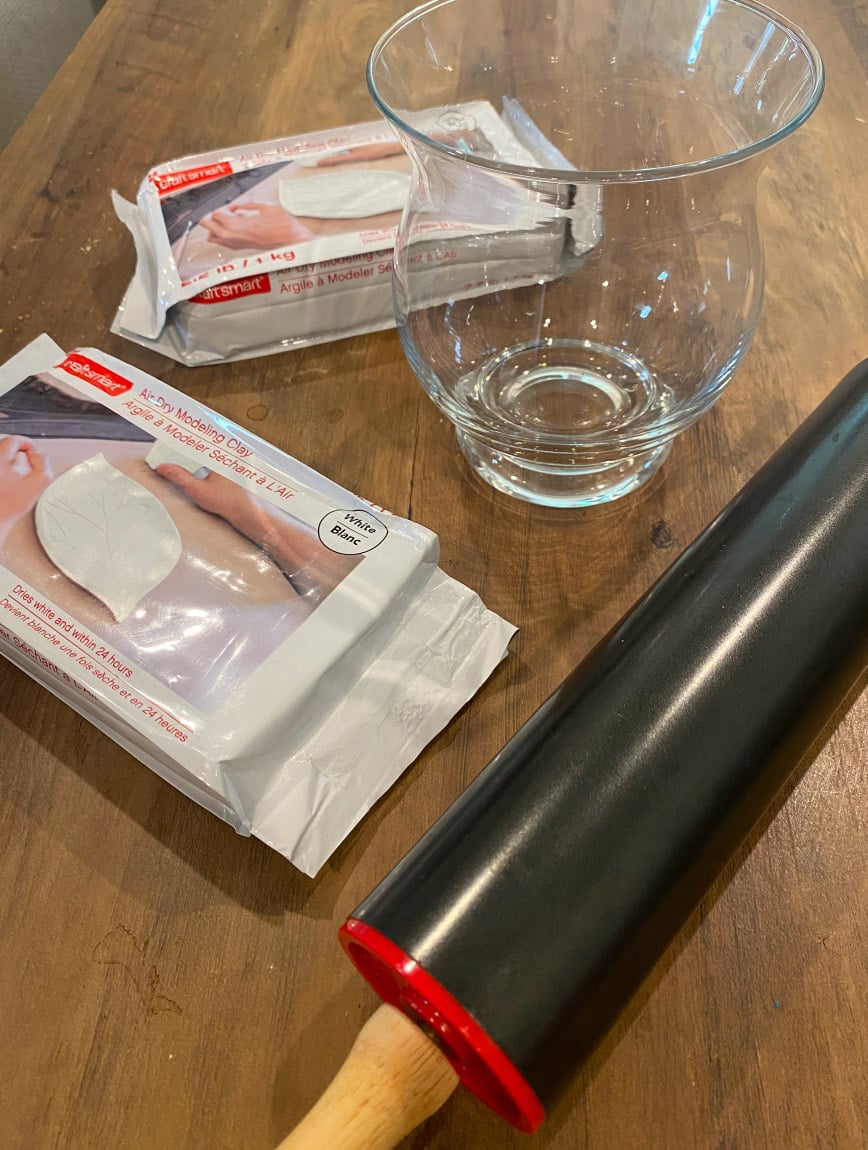
Ghost Vase
What You’ll Need
- Air dry sculpting clay
- A vase
- Paint – Grey or White (or any colour you can imagine!)
Directions
- Pop in some flowers, add water, and enjoy your spooky floral arrangement with blooms from your garden!
- Roll out your clay into a nice, even slab. It should be a little longer than the vase’s circumference. Cut it into a neat rectangle with straight edges at the top and bottom. Bonus points if it’s tapered so it flares out at the bottom like a ghostly skirt!
- Shape it around the vase. Try to keep it wider at the bottom to mimic loose fabric.
- Peek-a-boo! Cut eye holes into the clay so you can see the vase and your ghost can keep a watchful gaze on your guests.
- Optional: Leave your ghost au naturel or add a layer of paint for that extra cloth-like feel.
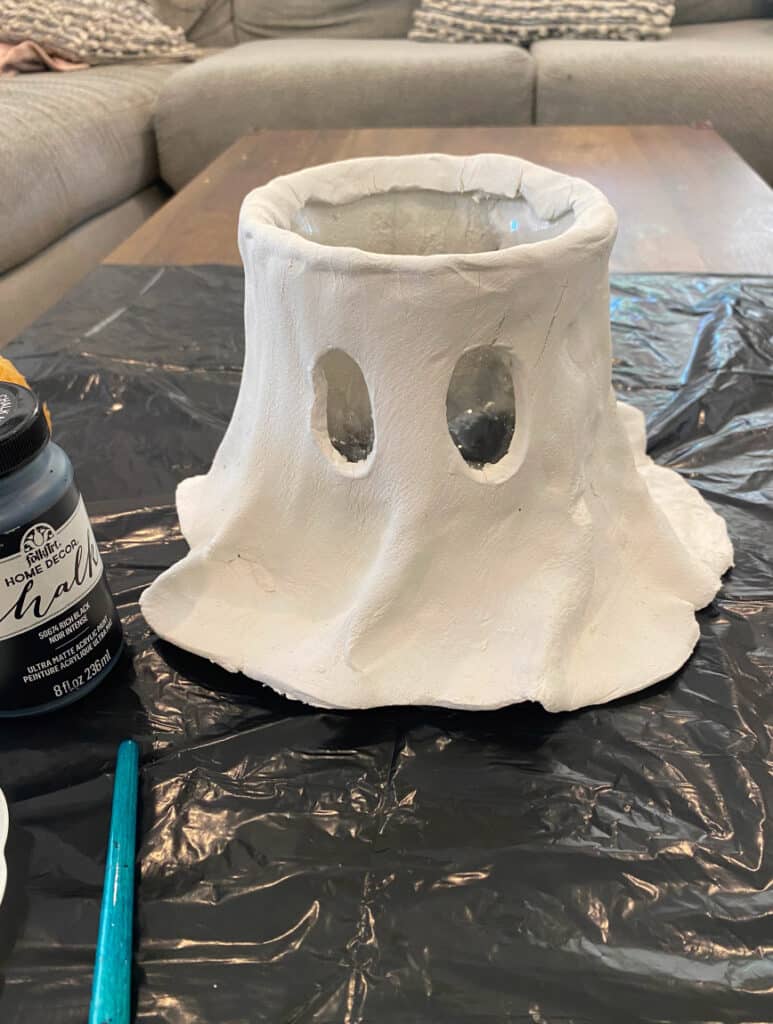
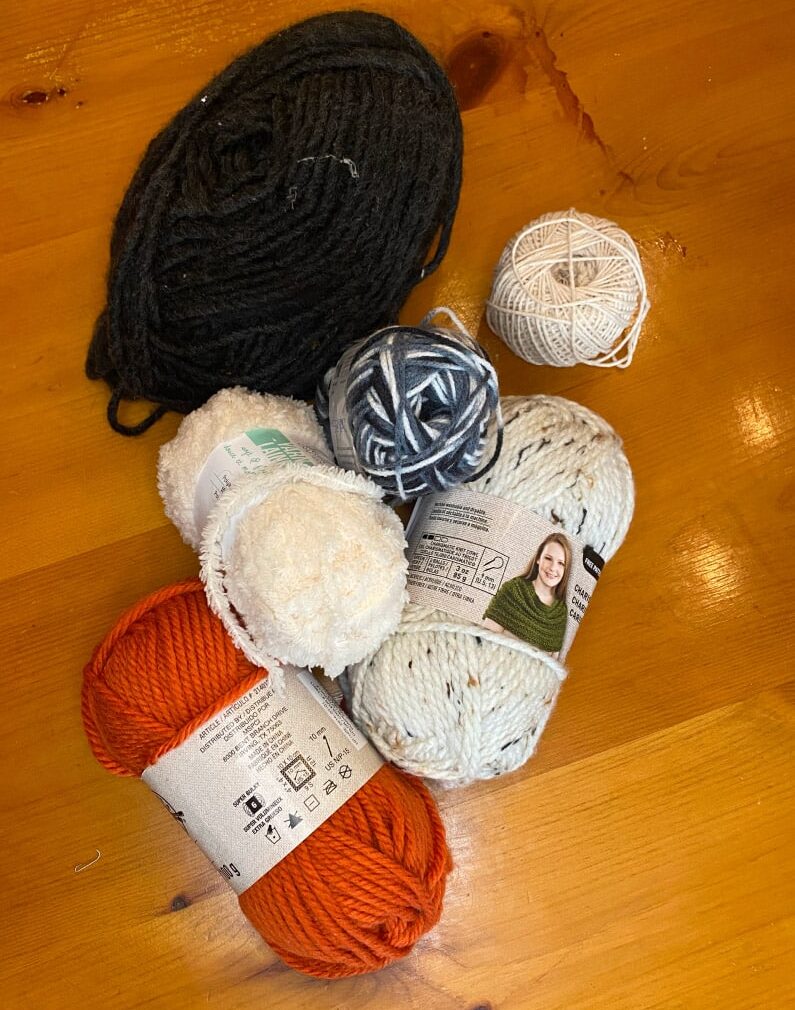
Ghost Garland
What You’ll Need
- A variety of yarns in different colours
- Yarn for hanging (macrame yarn or fishing wire works great)
- Felt for spooky eyes
- A clean toilet paper roll
Directions
- Cut your hanging yarn to the length you want your ghostly garland to be.
- Flatten your toilet paper roll
- Choose a yarn colour and wrap it around the roll about 30 times or until desired thickness.
- Tie the top of your yarn using the same colour and cut the yarn at the bottom where the toilet paper roll ends.
- Place your yarn pieces on the yarn used for the garland so where you tied it together is sitting on the garland yarn. Fold the top section of yarn over garland yarn. Using another piece of yarn (Same color as your ‘ghost’) wrap around the ghost and tie to create the head.
- Repeat the process until you’ve got a full ghostly gang!
- Cut out eye shapes from your felt (pro tip: use a hole punch for quick circles). Glue the eyes to your ghosts. We only added eyes to the white ones—let the others be mysterious Halloween pom-poms.
- Hang your spooky creation and enjoy!
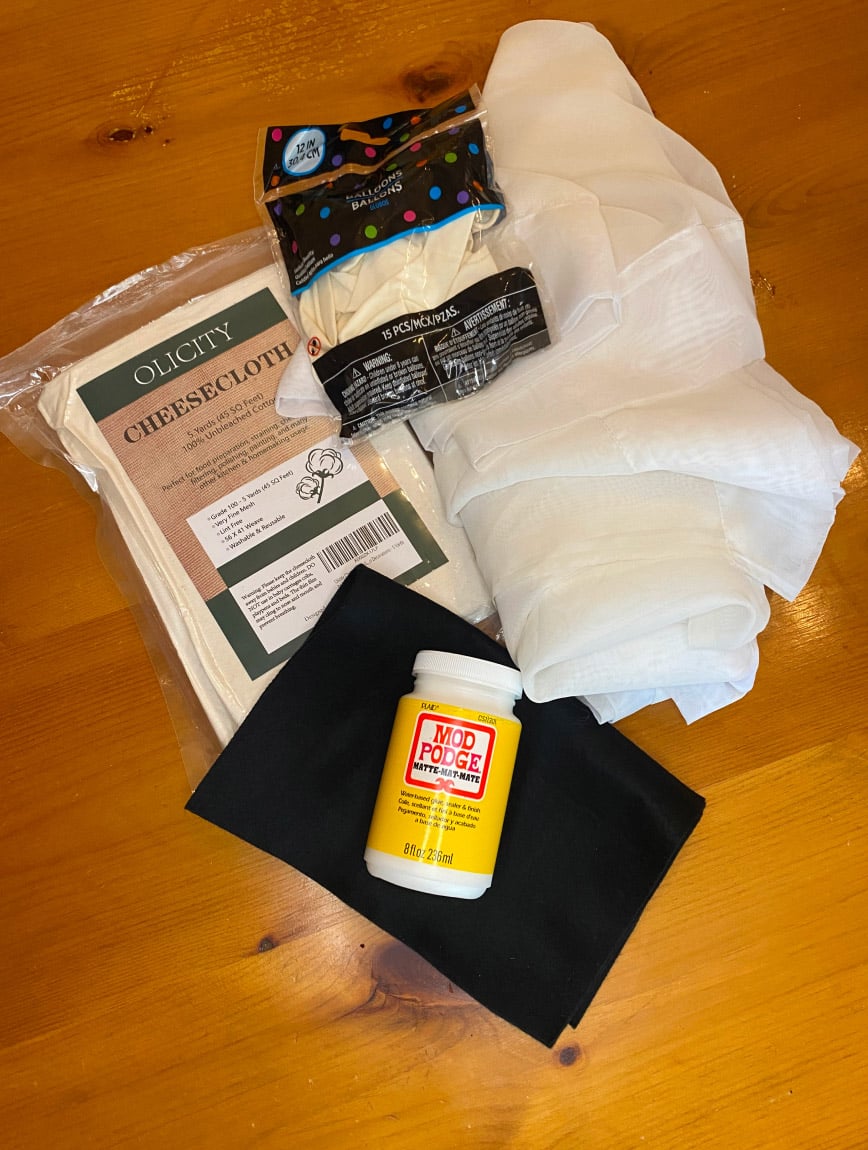
Cheese Cloth Ghost
What You’ll Need:
- Cheese cloth or any white fabric at hand
- Balloons
- Various cups, vases, or bottles
- Modge Podge or school glue
- Black felt
- Optional: Battery-operated lights for extra spookiness
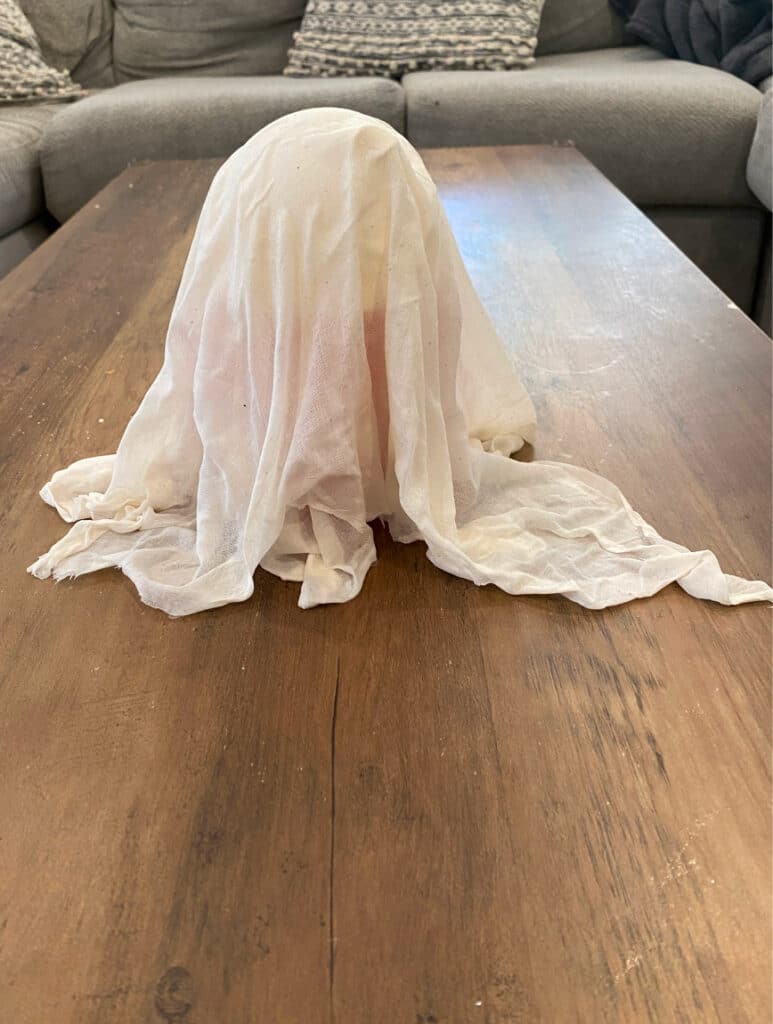
Directions
- Mix equal parts of Modge Podge or glue with water in a big container. Warning: it’s messy, so maybe use something disposable!
- Blow up your balloon to the size of your future ghost’s head and sit it atop a cup or vase of your desired height. Cut your cheese cloth to drape over the balloon and spill onto the ground.
- Drench the cheese cloth in the gluey mixture, squeeze out the extra goop, and drape it over your balloon and cup.
- Let your ghost dry overnight or for a solid 12-24 hours.
- Once dry, remove the cup, pop the balloon, and set your ghost free!
- Cut out eyes and mouths from felt and glue them on.
- Optional: Pop some battery lights inside for a haunting glow. Try different sizes for versatile spookiness: tall for doorways, small for tables, or hang them!
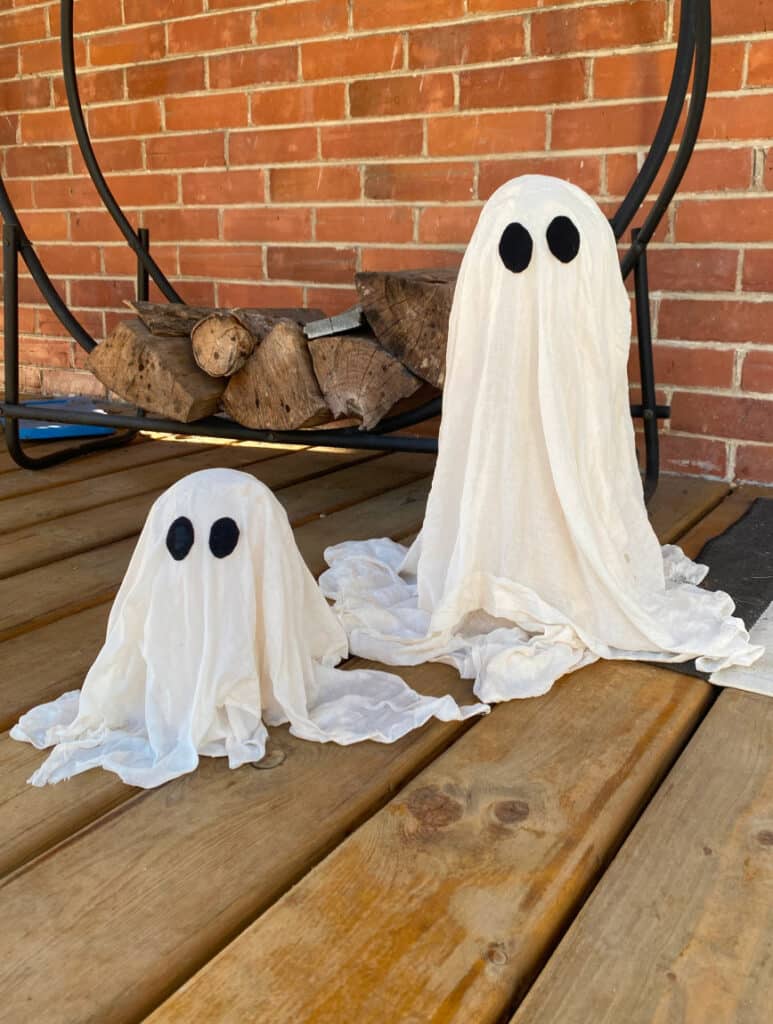
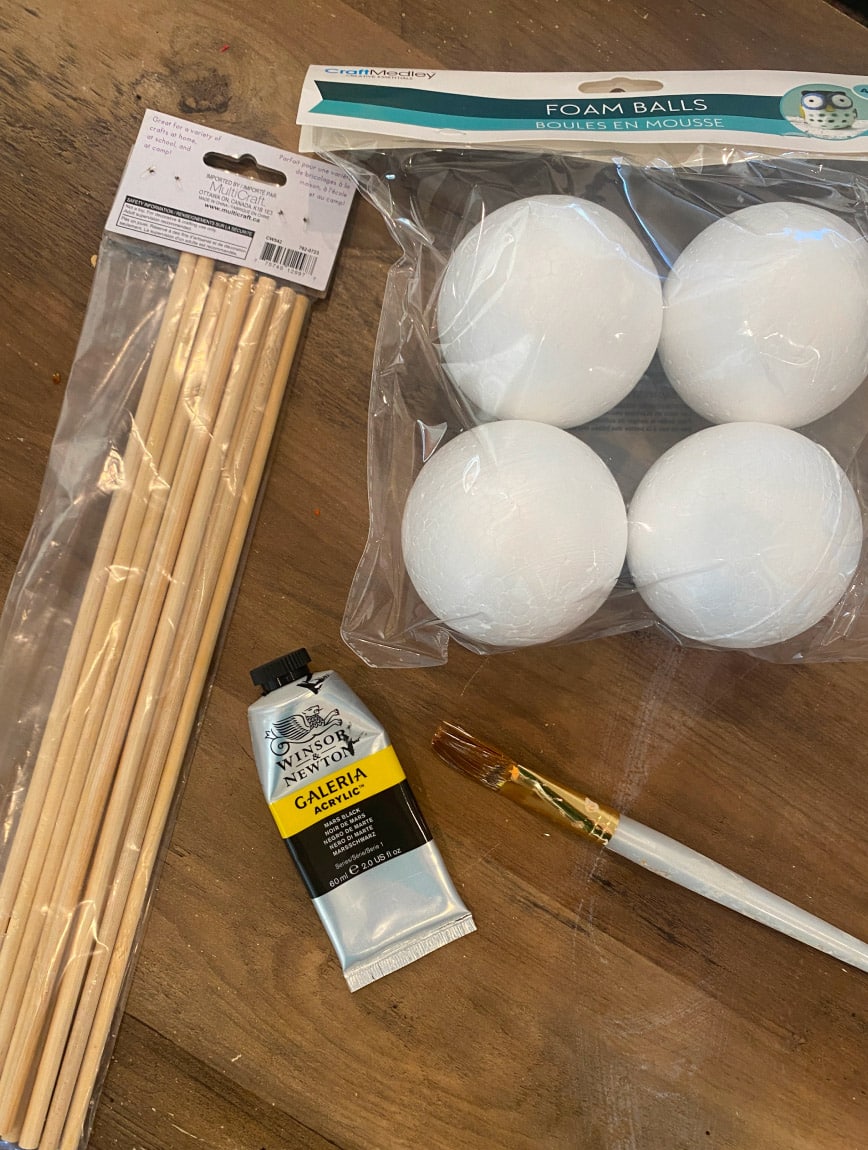
Plant Eyes
What You’ll Need:
- Cheese cloth or any white fabric at hand
- Balloons
- Various cups, vases, or bottles
- Modge Podge or school glue
- Black felt
- Optional: Battery-operated lights for extra spookiness
Directions
- Paint large, eerie black circles on each Styrofoam piece (or get creative with colours, glow-in-the-dark effects, or creepy veins). Tip: trace something round to draw circle before painting.
- Stick a wooden stake into the Styrofoam or glue it on for stability.
- Nestle these eerie eyes into your plants or bushes for a peeping effect!
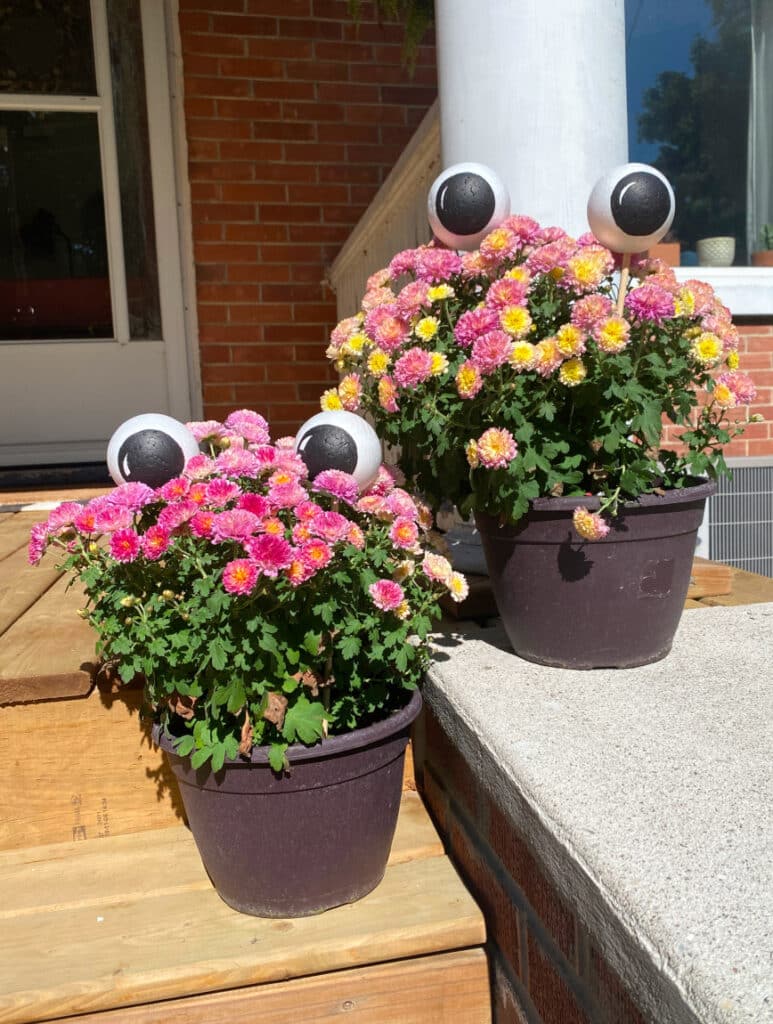
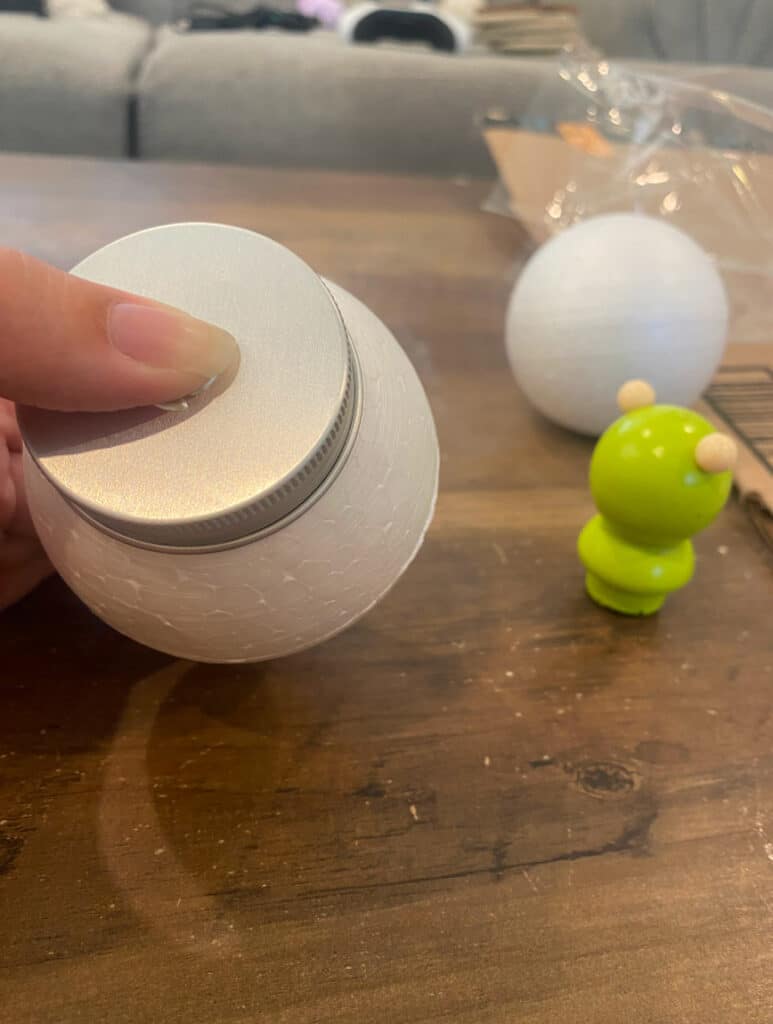
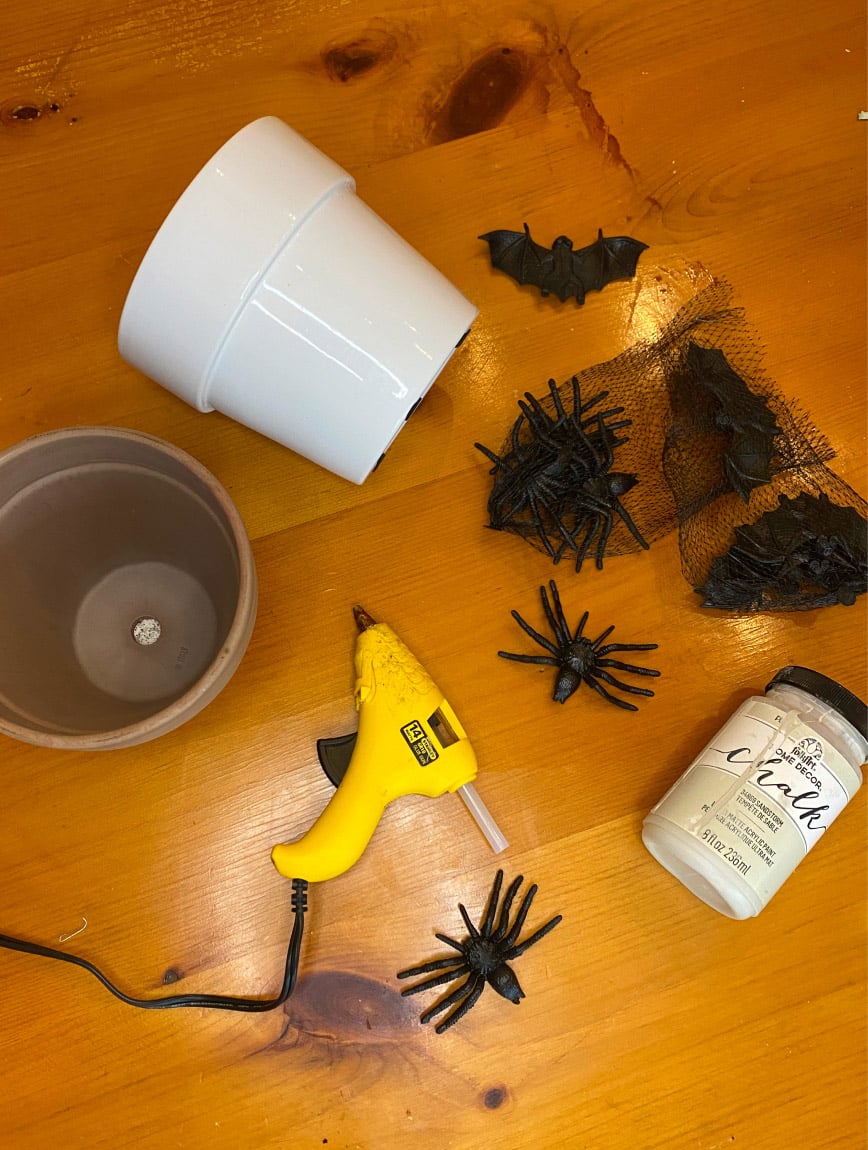
Creepy Planters
What You’ll Need:
- Planters
- Plastic spiders or other creepy crawlies
- Chalk paint
- Glue (a glue stick will do)
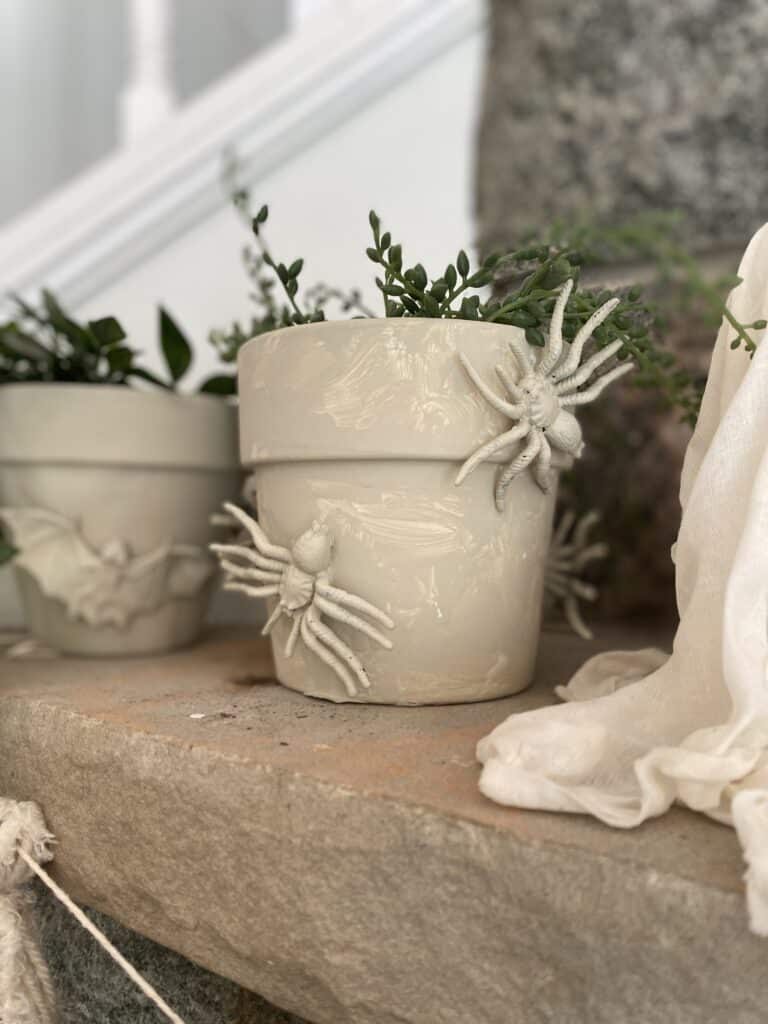
Directions
- Glue your creepy critters onto the planters.
- Paint over the planters and bugs with chalk paint (other paints work, but chalk paint sticks better, especially if your planters are shiny).
- Style with plants and watch your creepy creations come to life!
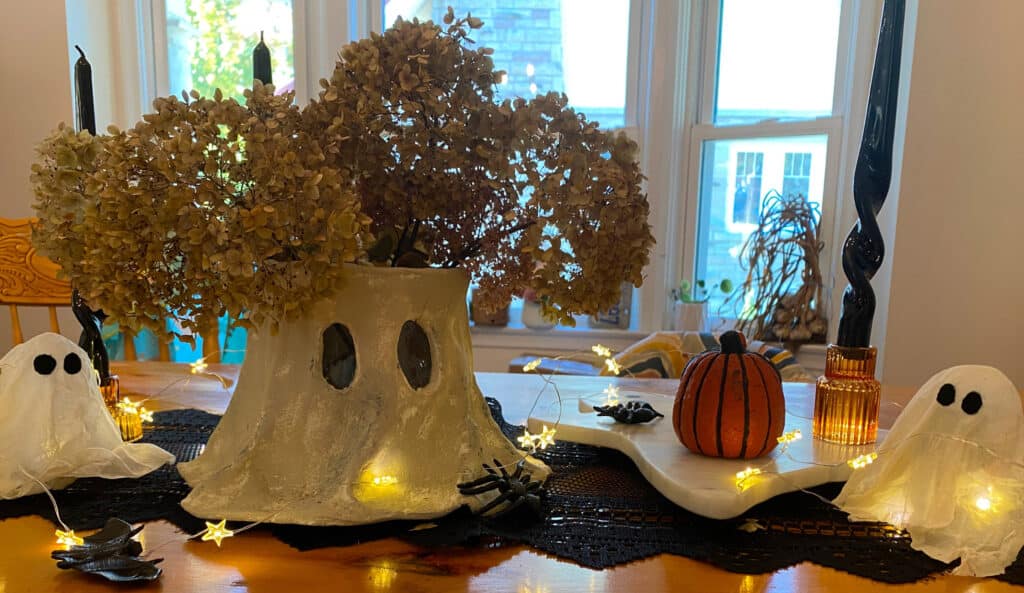
#happycreating!
Looking for a fun and sustainable way to store your freshly grown fruits and veggies? Use our DIY easy macramé produce net!
Not only will you end up with a chic, eco-friendly storage solution, but you’ll also get the satisfaction of creating something beautiful. Perfect for beginners and craft enthusiasts alike, this project promises to add a touch of handmade charm to your kitchen or pantry.
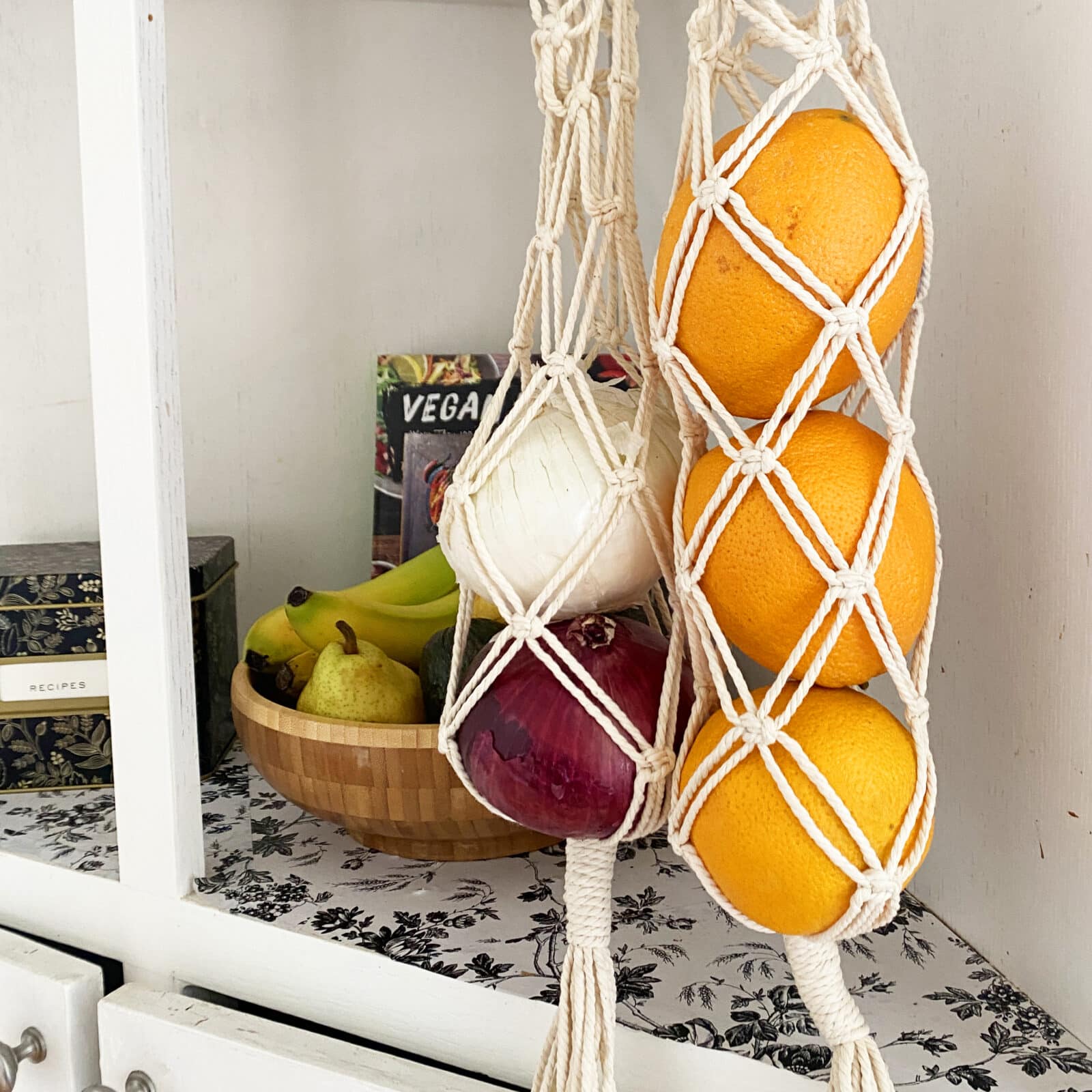
Here’s what you’ll need:
-
3mm Macrame Yarn
-
Scissors
-
Masking Tape
step 1
Cut macrame yarn into 8 pieces measuring about 120” long. You can tape the ends of the yarn to avoid the yarn from fraying.
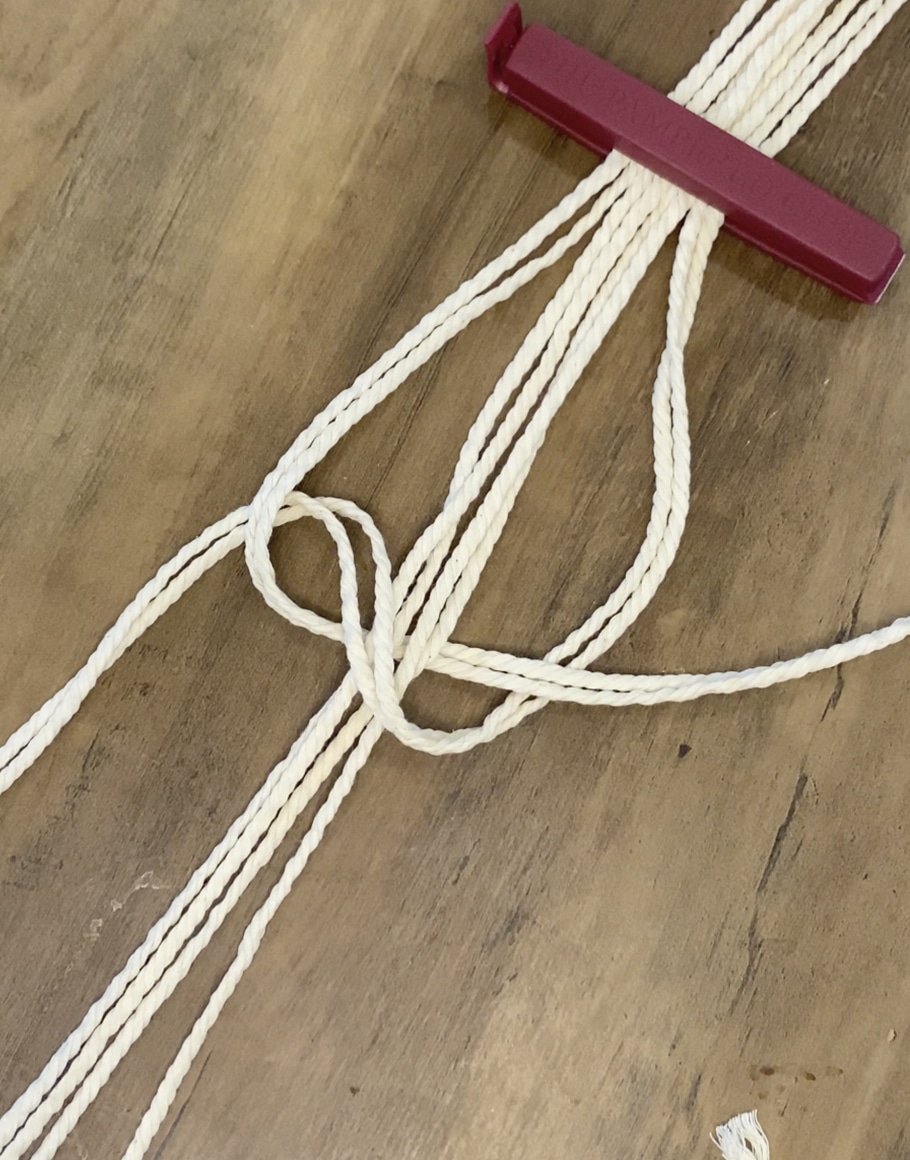
step 2
Gather the 8 pieces cords and find the center. Create the handle by making a vertical row of Square Knots. Tie the Square Knots with 4 cords grouped together in the middle, 2 cords on the left, and 2 cords on the right. Make 18 vertical Square Knots to make the handle.
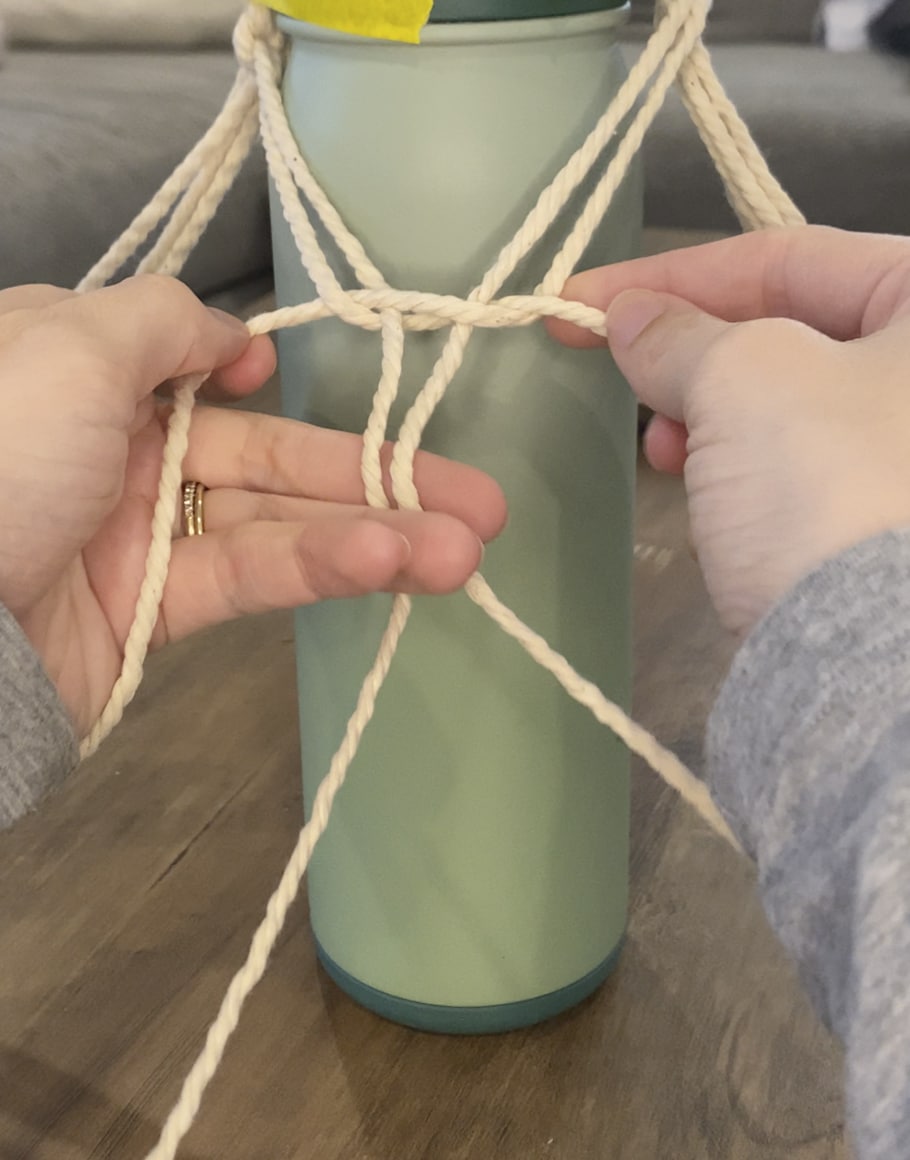
step 3
Tape the handle to the top of a slender water bottle. This can help to make a form for the bag’s shape. Then take two cords from each handle and tied them together in a Square Knot. Make sure you don’t space out the rows too much, keep them as close and as tights as possible.
step 4
After the rows of Square Knots reach the bottom of the water bottle, un-tape the handle and gently pull the bag up. Re-tape and continue making more Square Knots. Do this until you reach your desired length of the bag.
step 5
When finished weaving the body, make a Wrapping Knot. Trim the tassel to your desired length and fray. Start filling your produce bag with veggies or fruit of your choosing!
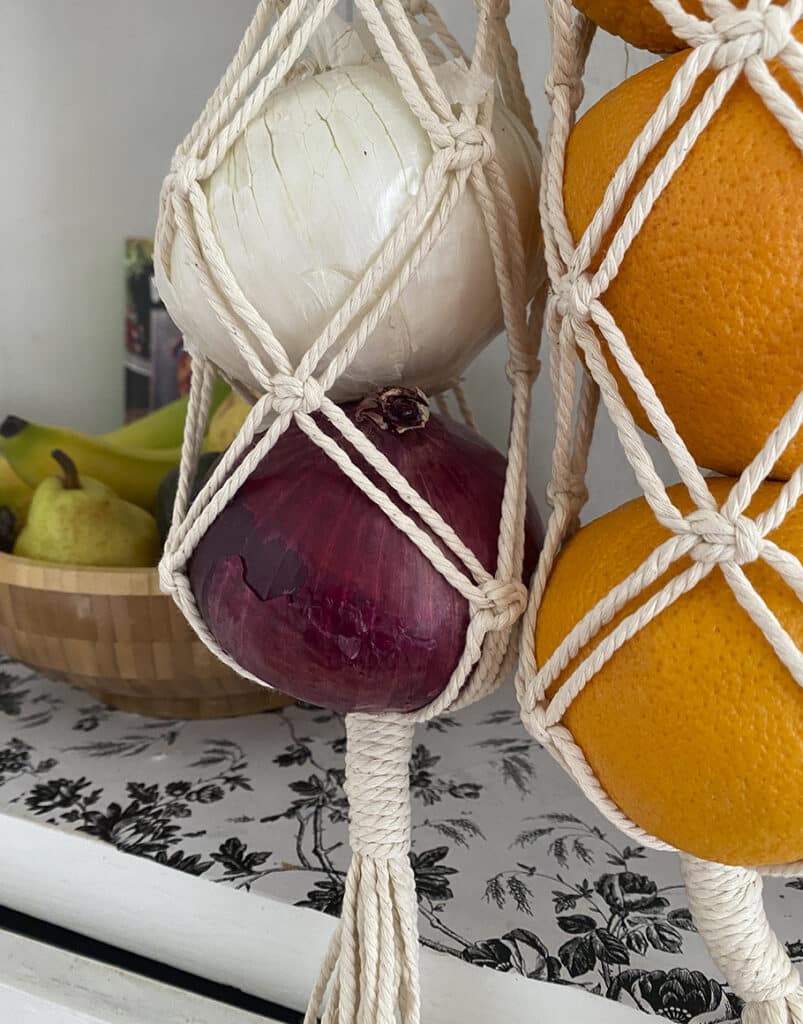
#happycreating!
These delightful DIY flower-shaped seed bombs are an ideal gift for Mother’s Day.
Show your appreciation for MOM by using your imagination and customize with your favourite shapes or colours!
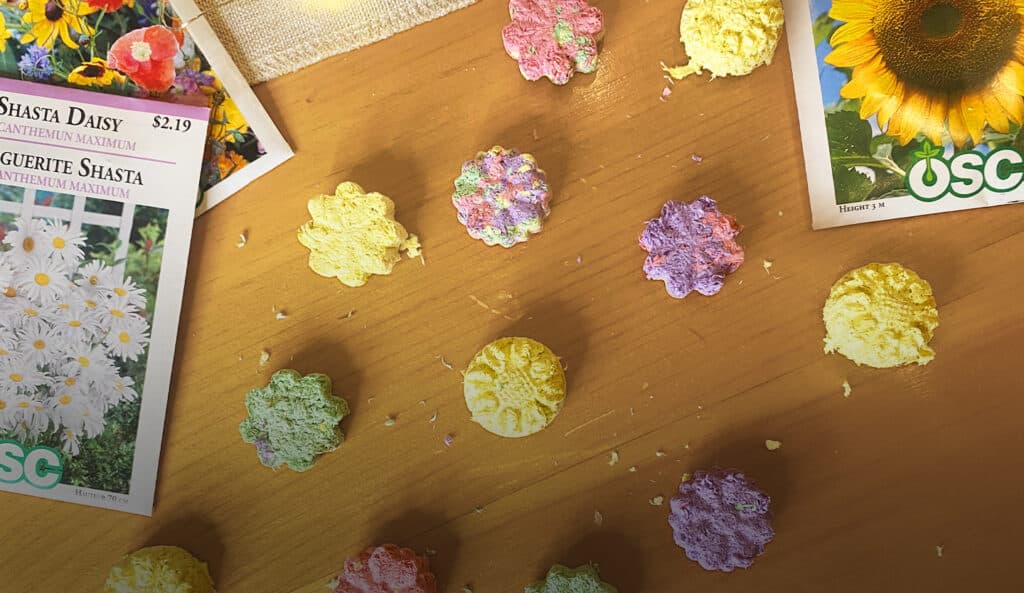
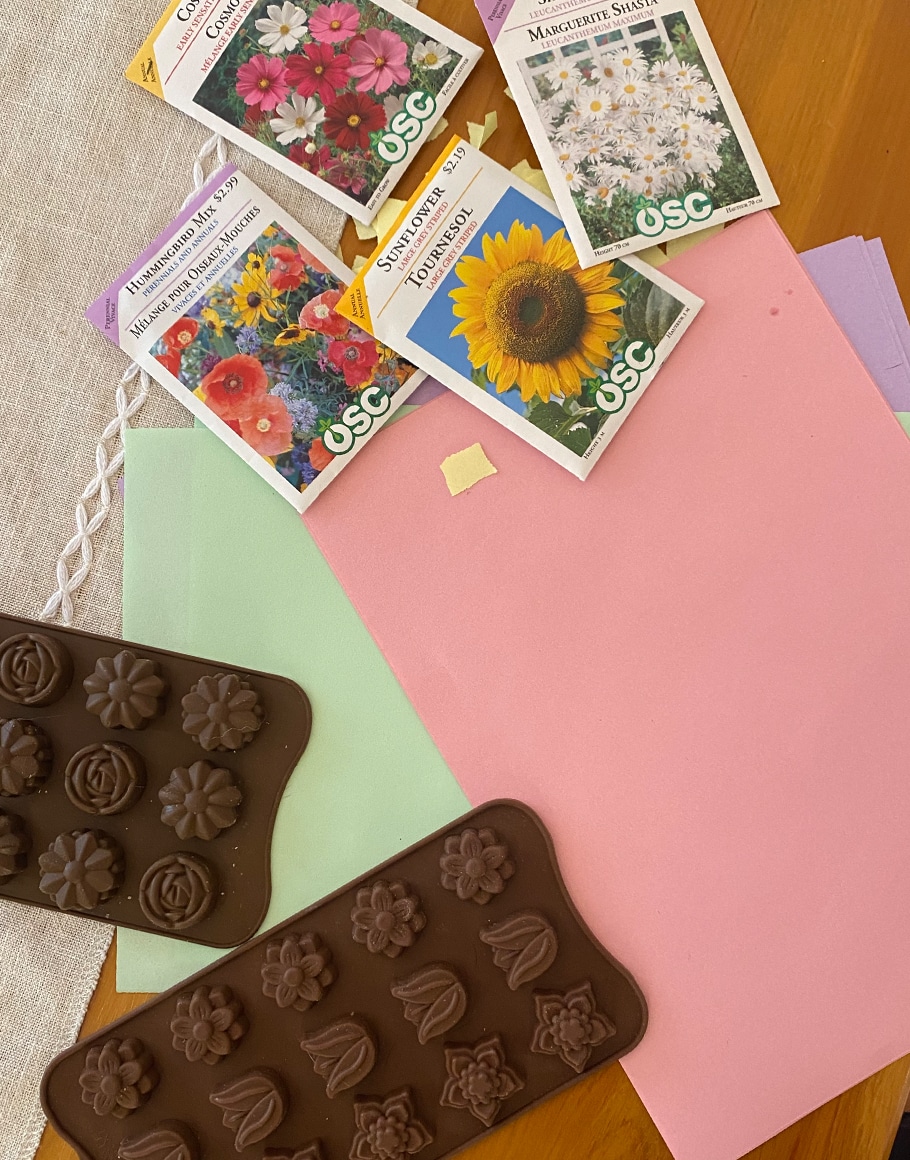
Here’s what you’ll need to get started and create these plantable treasures:
Tools:
- Blender
Materials:
- 1 packet of your chosen seeds
- 1 sheet of your favourite coloured paper
- 1 silicone mould in the form of flowers or any design you fancy
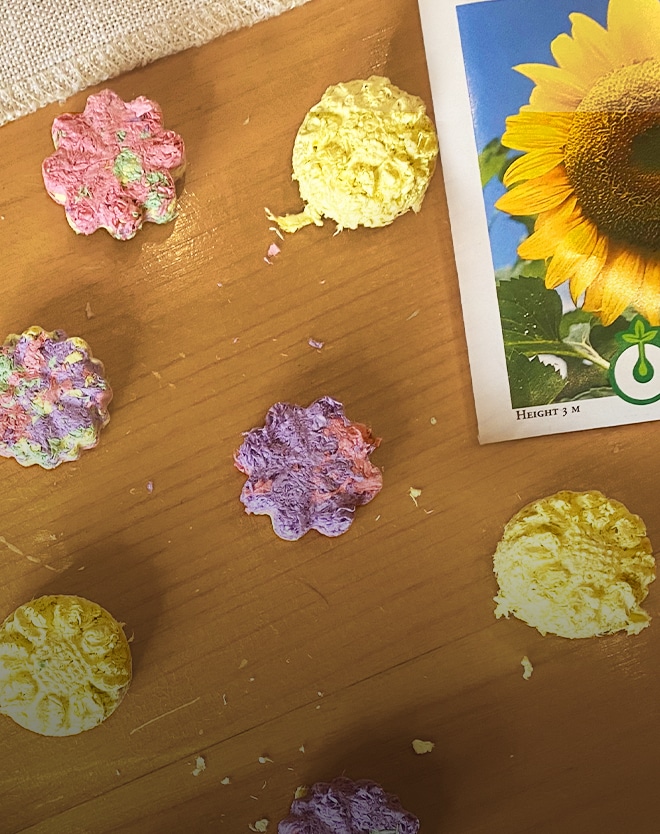
step 1.
Begin your project by tearing the coloured paper into confetti-sized pieces.
step 2.
Submerge the shredded paper in water in a bowl. Allow it to soak for up to 20 minutes.
step 3.
After soaking, remove the paper from the water and transfer it into the blender. Blend it until you achieve a fine, wet pulp consistency.
step 4.
Squeeze out any extra moisture from the paper so it’s not dripping wet.
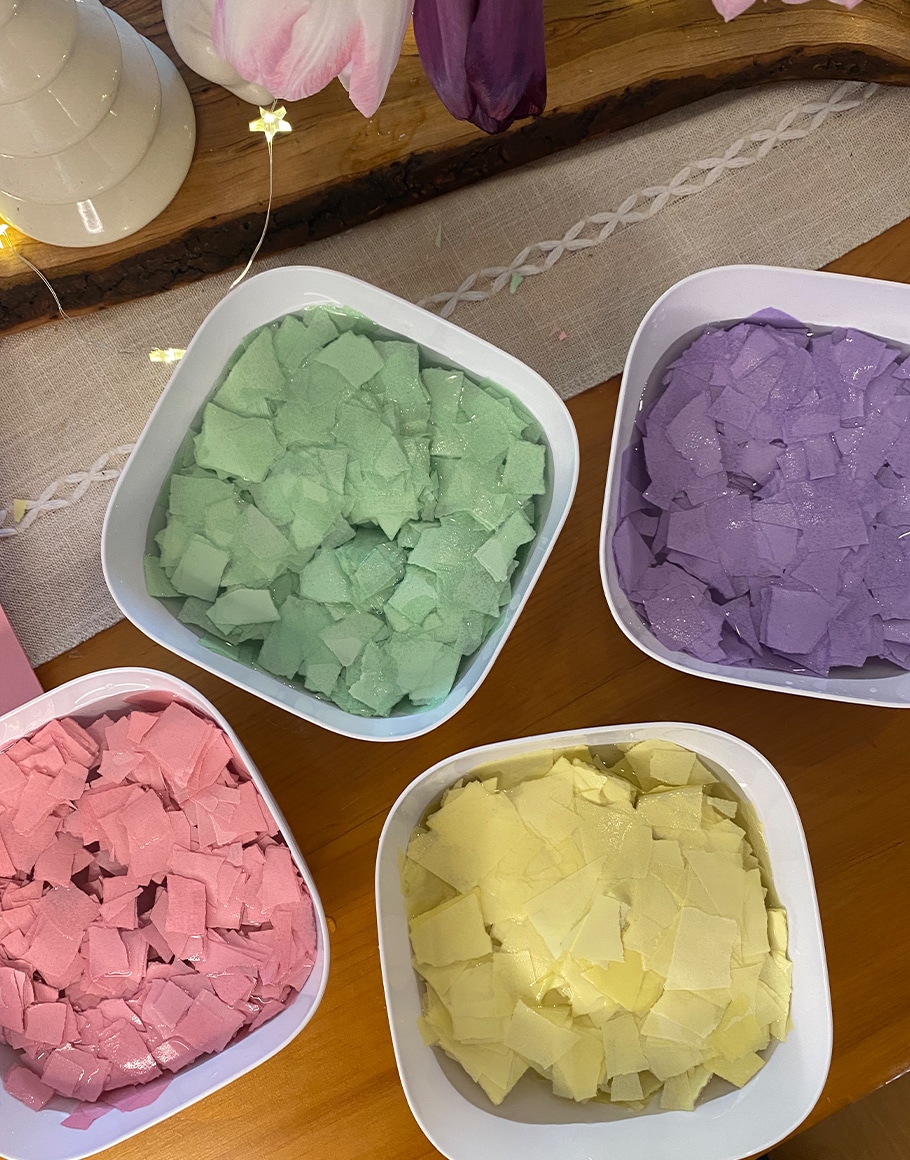
step 5.
Press the paper halfway into your mould.
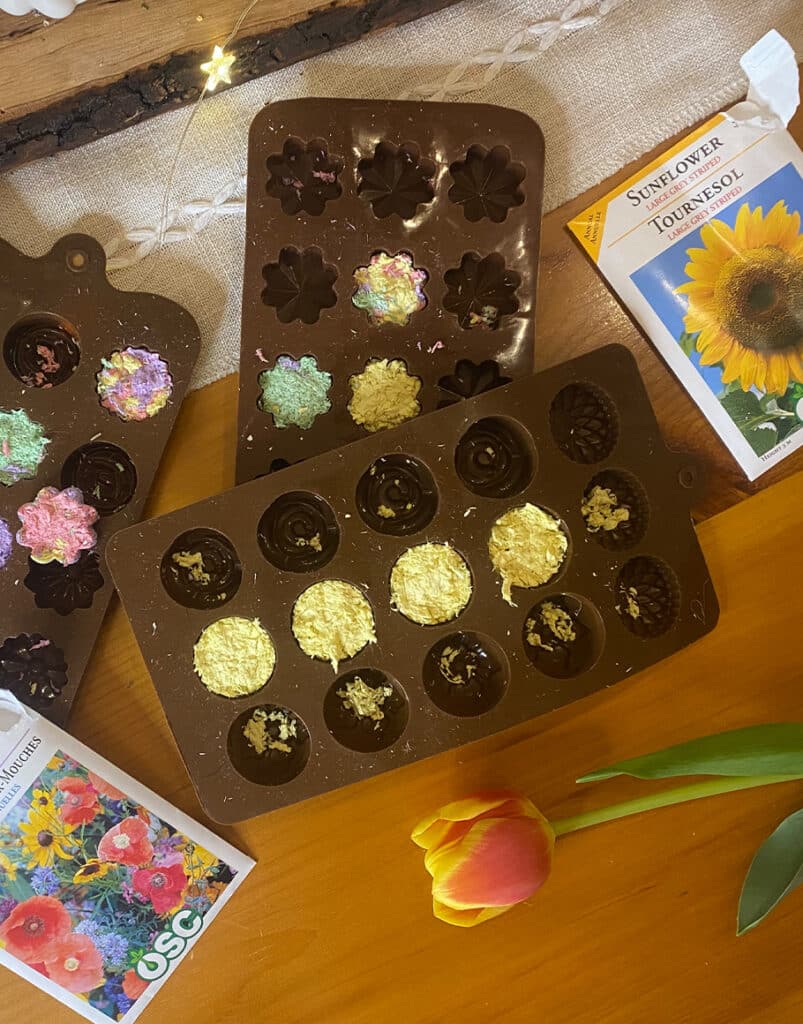
step 6.
Delicately sprinkle the seeds on the paper, then cover them with another layer, filling the mould to the brim.
step 7.
Patience is a virtue as you wait for the seed bombs to dry in the mould. This will take approximately 2 to 3 days.
step 8
Once fully dry, remove your seed bombs from the mould with care.
Voilà! Now you have a handful of flower-shaped seed bombs, ready to sprout into life or as a heartwarming present for Mom. The perfect gift, with love and growth wrapped into one.
Share your seed bombs using #PlantProject or tag us @plantprojectcanada and join our community.
#happycreating!
Whether you’re new to the world of hoyas or a hardcore hoya collector, getting these gorgeous plants to bloom can be such a rewarding experience.
Hoya blooms only last a few weeks, which makes it feel extra special when it does happen. If you’re having a hard time making those cute little star-shaped flowers appear, these tips will help set you up for success.
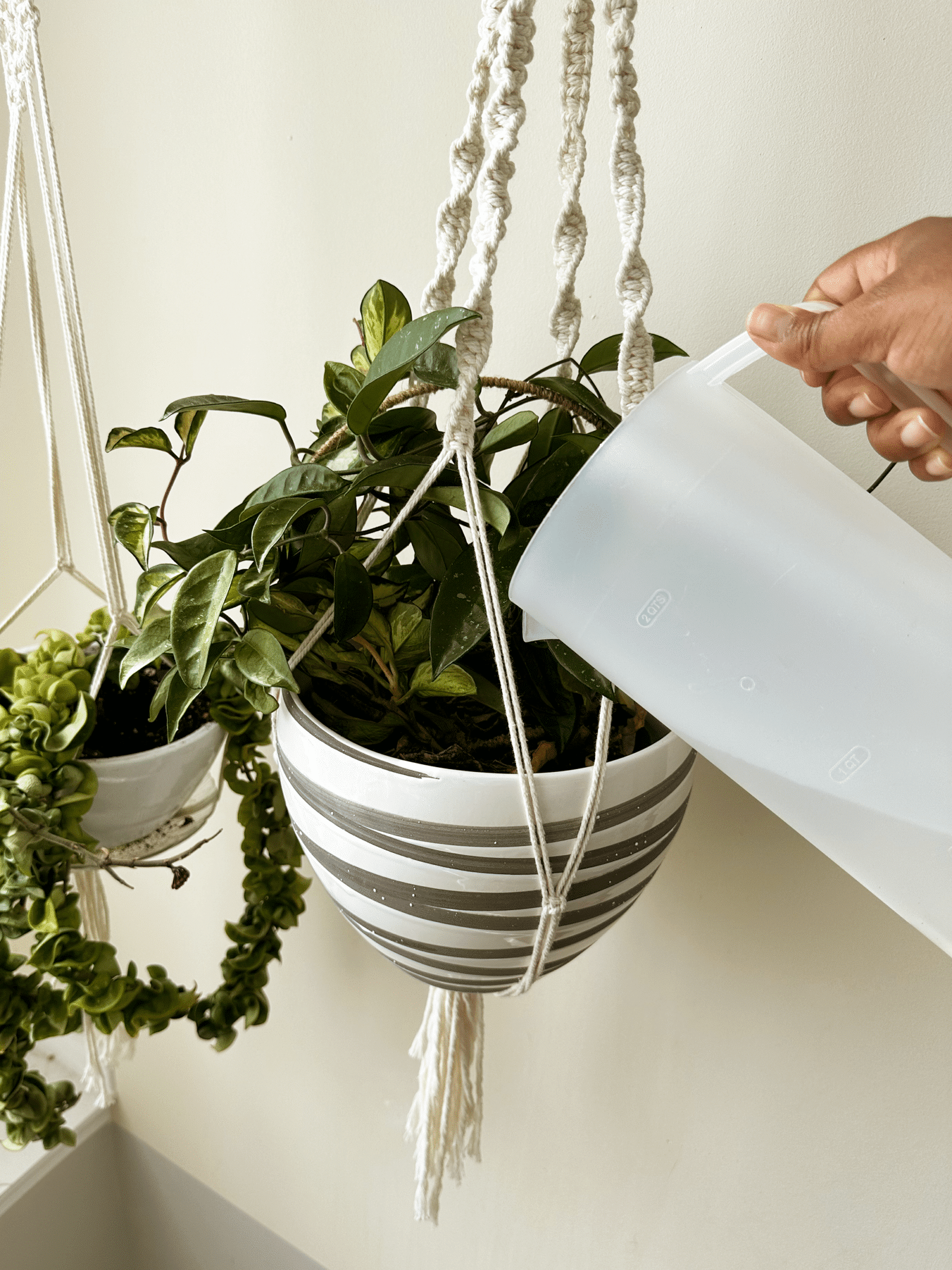
don’t overwater!
Letting the plant’s soil dry out between waterings puts a little stress on it to survive, which in turn encourages it to put out new flowers to try to ensure its survival. Rather than relying on a watering schedule to tell you when to give your hoyas a drink, touch the plant and soil. If you squeeze a leaf between your fingers and it’s squishy, time to water; if it’s firm, wait a couple days and check again. If you stick a finger in the soil and it feels dry to the touch, it’s time to water; if it feels damp, wait a few days as well.
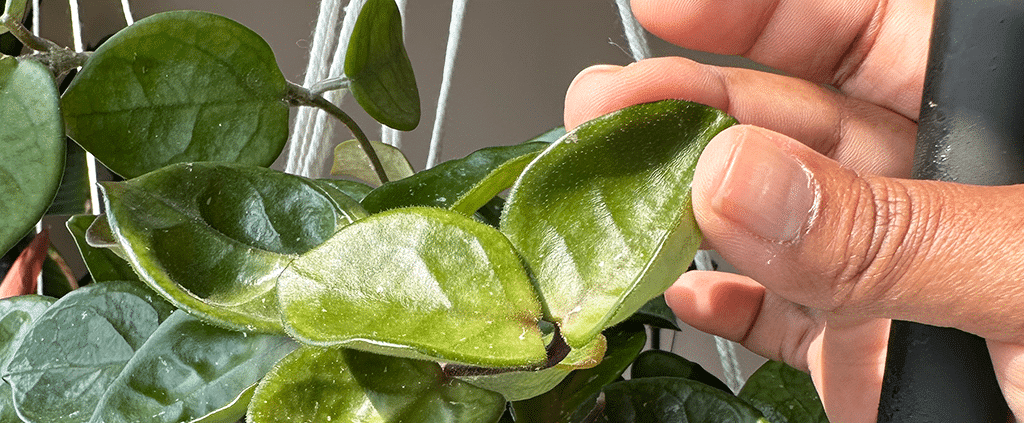
make sure your hoya gets lots of light – like, LOTS of light.
Not only are hoyas hardy plants, but hoyas are also tropicals, so they thrive in bright light. My hoyas that flower most frequently get a few hours of direct sunlight each day, and bright indirect light the rest of the day. In my experience it’s hard to give these plants too much light – if exposed to 6+ hours of direct light a day, they may even start to show the pretty patterns typical of a sun-stressed plant.
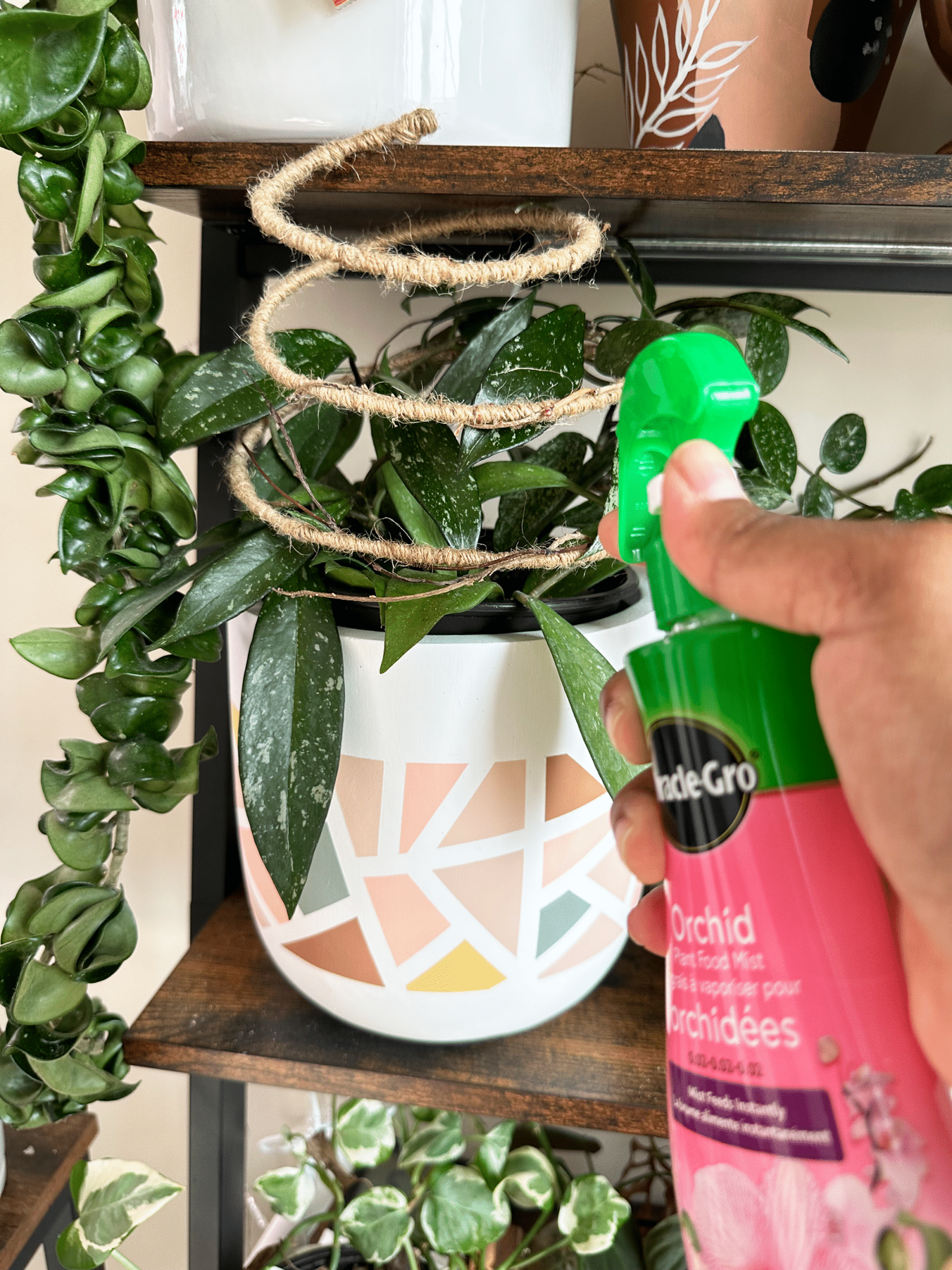
feed me, see more…flowers!
If you want a plant to put out new growth or blooms, it needs the nutrients to do so. Although you can of course use a tropical plant food the next time you water your hoya, I’ve had great luck fertilizing mine with the Miracle-Gro Ready-to-Use Orchid Plant Food Mist. Like orchids, hoyas are epiphytes. In the wild, epiphytic plants grow not in soil, but attached to other plants, and absorb water and nutrients from the air. Spraying plant food on in the form of a mist allows a hoya’s leaves to absorb those nutrients the same way they would in the wild.
#easypeasy
This plant’s been in the same soil since I got it years ago and is due for a repot. Although it hasn’t outgrown its pot, the soil is extremely dry and no longer retains the moisture the plant needs. So here’s how to repot a plant while changing out most of its soil!
here’s what you need to get started:
- your plant
- a nursery pot
- a quality potting mix (this ficus elastica is a tropical plant, so I’m using Miracle-Gro Tropical Potting Mix)
- a potting mat or tarp (optional)
- a shovel or soil scoop (optional)
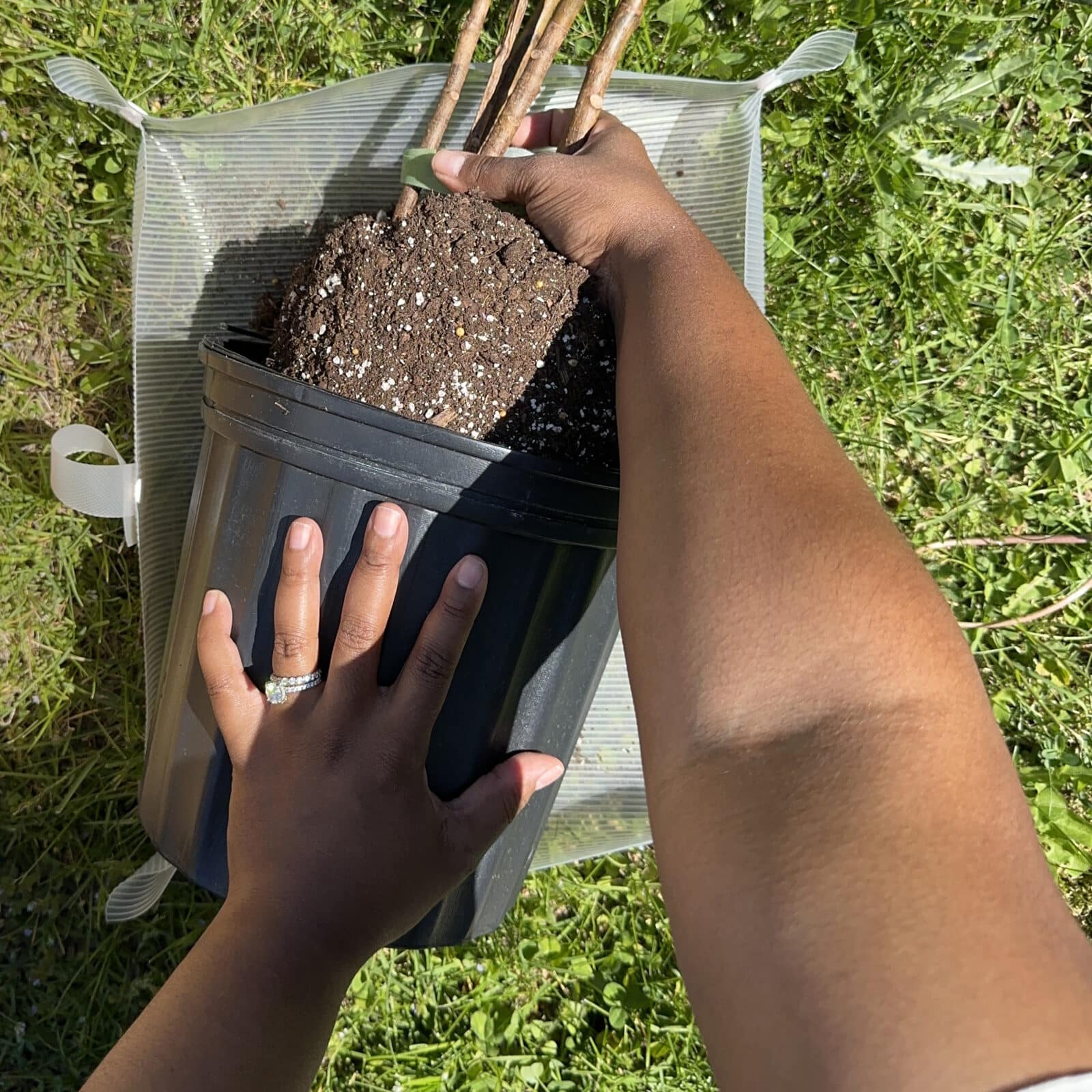
step one.
The first step is to gently coax the plant out of its pot. I did this by laying to pot on its side and gently squeezing and rolling the soft plastic of the nursery pot. Then pull the plant out of the pot.
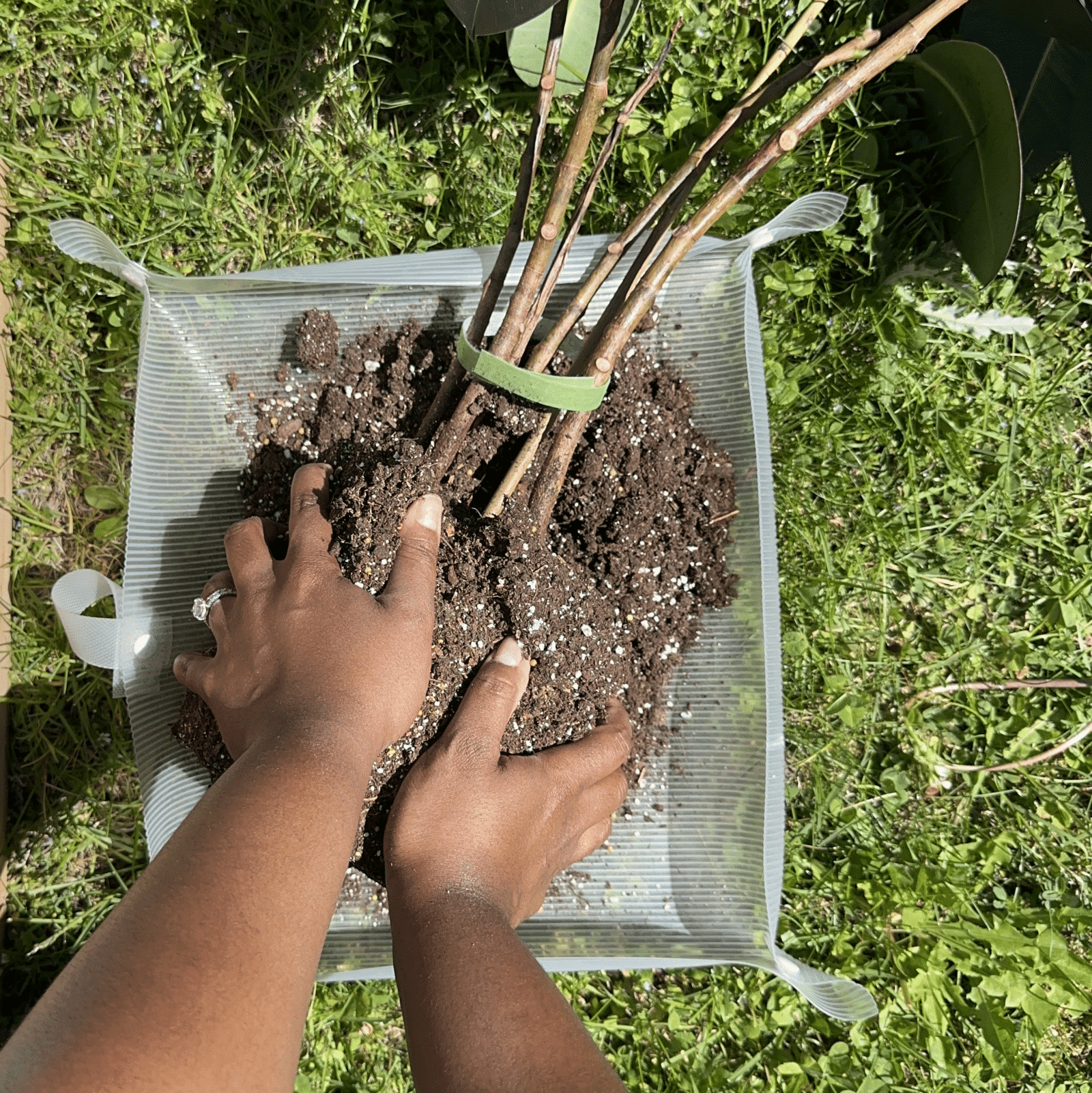
step two.
Using your fingers, begin to gently remove some of the old soil from the root ball.
Plants don’t particularly like having their roots disturbed (think about it: how often does someone come along and dig a plant up to tear apart its roots in the wild?) and being too rough can cause damage which can lead to root rot. You do want to remove some soil, though, so the roots can access the nutrients in the fresh new soil.
TLDR, gently remove as much soil as possible while doing as little damage to the roots as possible.
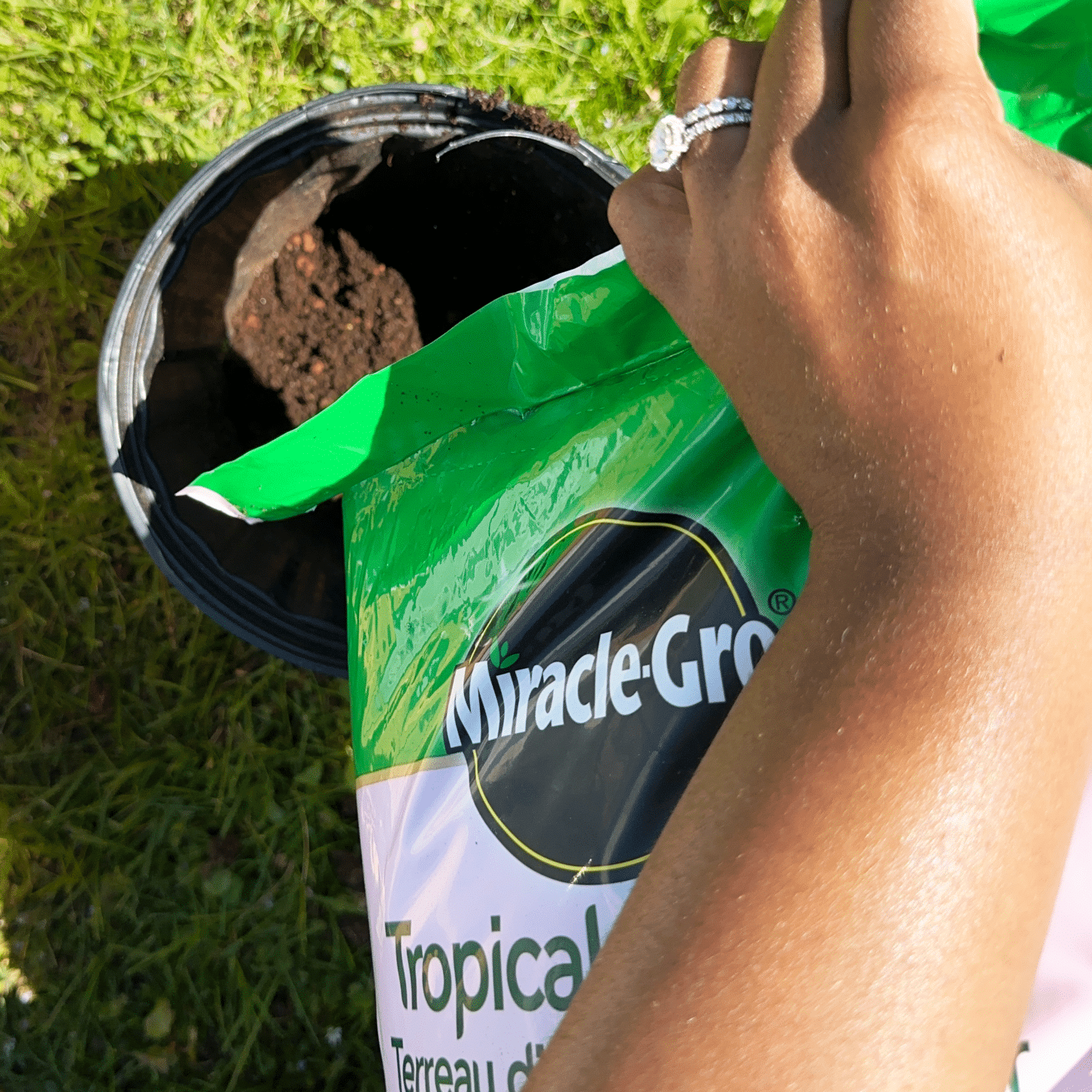
step three.
Grab the pot you’re planning to pot the plant in. The rule of thumb is to choose a pot that’s ~2 inches bigger than the root ball. (I decided to plant mine back in the original pot, as it was still an appropriate size, it was just the soil that needed changing.) Fill the bottom of the pot with a couple inches of soil. Then place your plant in and fill the sides and top with soil!
step four.
I like to wait a week or so after repotting before watering the plant. That way, hopefully, any root damage should form a callus and avoid root rot with the additional moisture.
#easypeasy
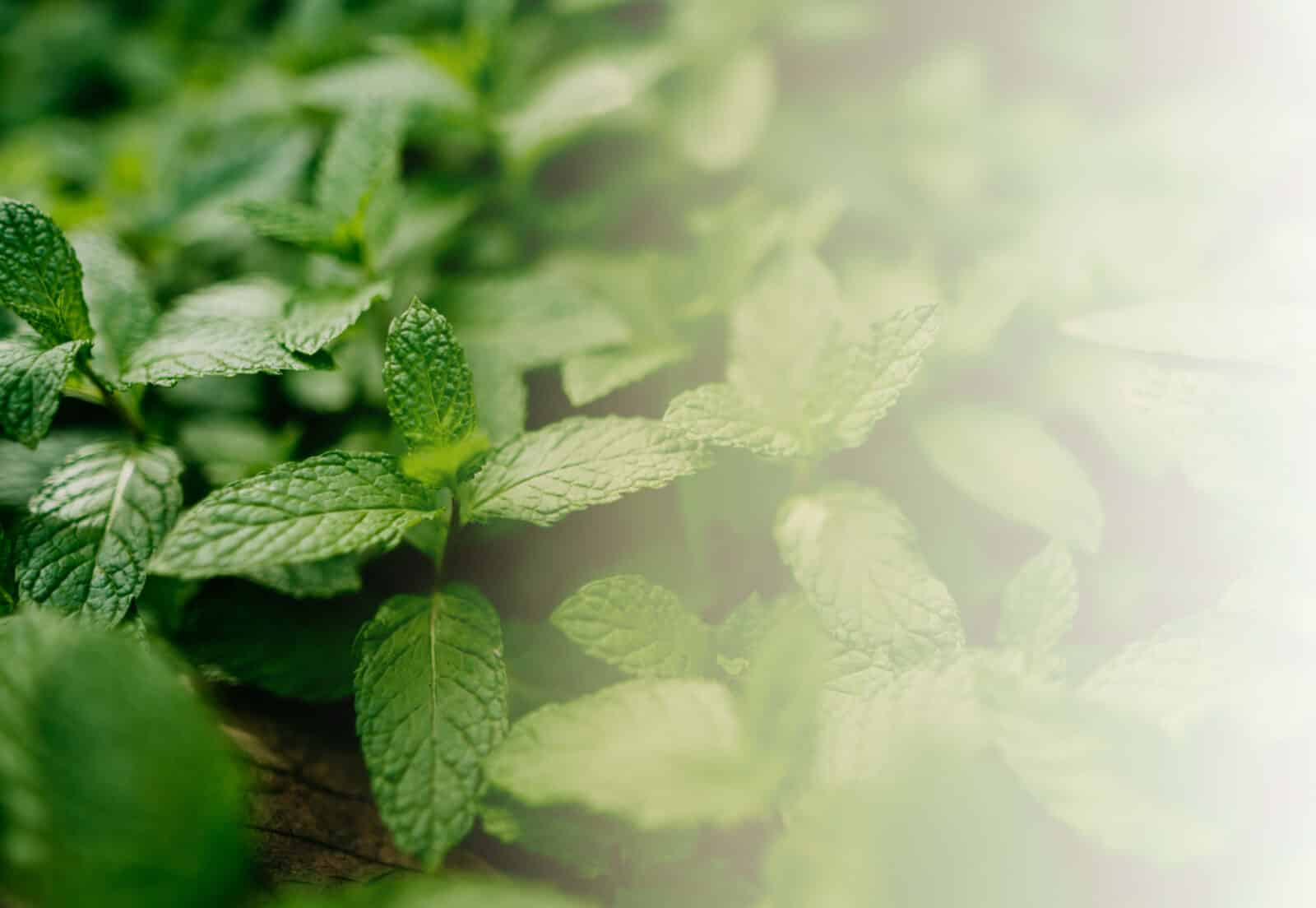
mint
aka mentha
Mint is an easy, fast-growing herb that is used in drink and food recipes. It is a perennial herb that grows little white and purple flowers. There are over 30 different variations of mint, but the most commonly grown is spearmint and peppermint.
variations
Apple/Pineapple Mint, Corsican Mint, Pennyroyal, Peppermint, Citrus Mint, Spearmint
light
full sun
If the soil is nice and moist, full sun is okay. Mint can also thrive in partial shade.
water + feeding
thirsty
Should be watered at least twice a week.
toxic
no
This plant is safe for animals to nibble on.
size
small to medium
Mint can grow to between 1 – 2 feet tall.
pro tip
An effective remedy for headaches
If you are prone to tension headaches, you can make a compress out of mint leaves for your forehead or rub peppermint oil on your temples.
fun fact
Ancient origins
Mint was used in ancient Greece, Rome, and Egypt
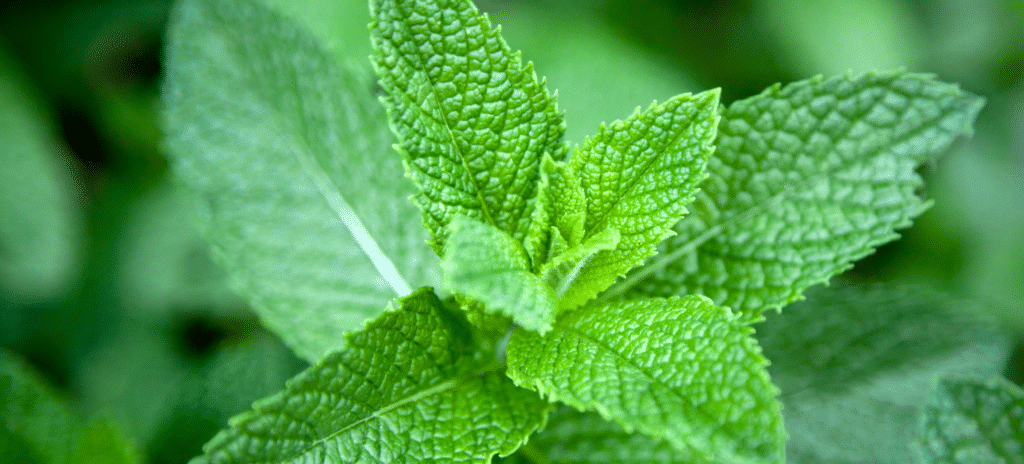
beyond the basics
-
soil + potting
Mint does not need to be fussed over which makes it perfect for first-time gardeners. When planting your mint consider using a well-draining soil that can help with moisture control, like Miracle-Gro® All Purpose Garden Soil. This soil helps to prevent from over- and under-watering your mint plant.
-
companion planting:
Luckily, mint is an easy herb to find companion plants for. You can take your pick of popular home garden veggies such as: carrots, cabbage, kale, tomatoes, bell peppers, beans and even zucchini.
-
harvesting
Frequent harvesting is important to keeping your mint flourishing. Young leaves have more flavour than older leaves. With this in mind, you can start harvesting your mint as soon as it comes up this spring.
-
pest control
If you see your mint plant drooping, there might be a pest problem. Common pests you might see with mint plants are aphids, mealy bugs, spider mites, or flea beetles. If you are seeing curling leaves or holes in your leaves, these are tell-tale signs of pests. Don’t worry, there is an easy fix. You can use a gentle insecticide like Ortho® Bug B Gon® ECO Insecticidal Soap Ready-To-Use to safely and quickly get rid of those little nuisances.
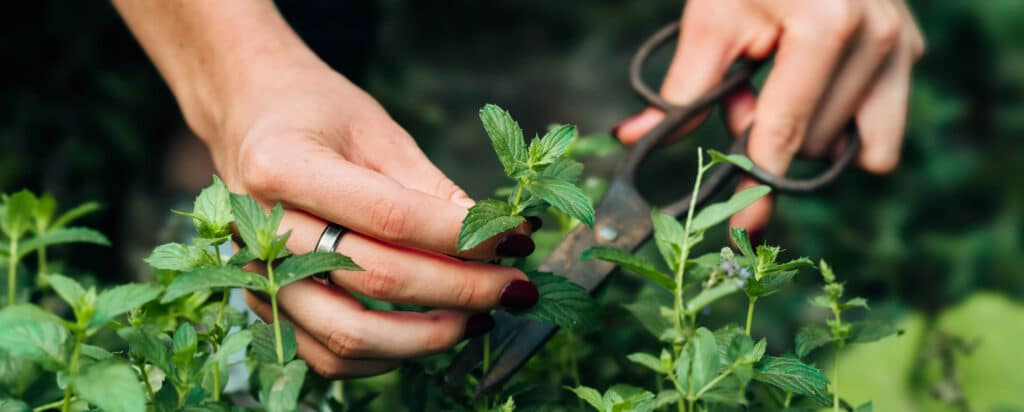
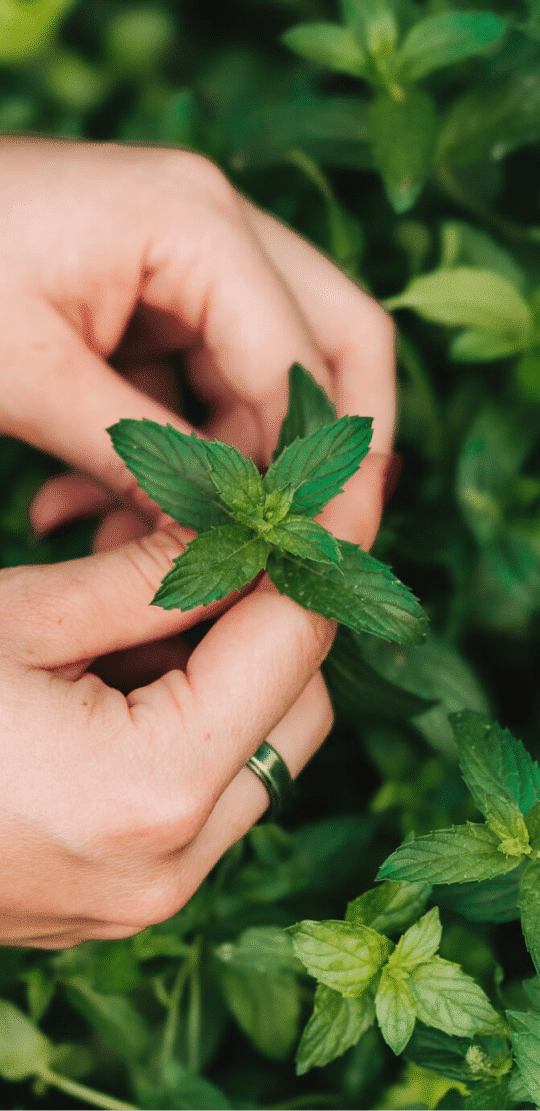
troubleshooting
-
What do I do with my mint once I harvest it?
You’ve got options.
Once you pick a few sprigs from your mint plant, you can keep them in water for a few days. It is best to use your mint while it is fresh, about 3-5 days. If you are looking to dry your mint leaves, cut them right before flowering and let the leave air dry. Once dry, store the dried mint in an air-tight container.
Or you can just pick the leaves from your mint plant as you need them.
-
Why is my mint looking leggy?
More sunlight. Most of the time, if your mint plant is looking thin and leggy it is lacking sunlight or water or nutrients. The best way to prevent mint from getting leggy is to make sure it is growing in a warm spot that gets lots of light. Keep it in a big pot with well-draining and nutrient rich soil.
-
Why is my mint turning crispy and brown?
Under-watering. This is easy to fix. Try watering your mint on a schedule, aiming for once or twice a week. Be sure to water under the leaves and close to the soil so you don’t damage the leaves.
-
How do I know if my mint is healthy?
Healthy, ready to use mint is a deep, rich green. If your mint is yellow and falling, it is likely due to its growing conditions. Keep your mint plant in full or partial sun, with a well-draining potting mix like Miracle-Gro® All Purpose Garden Soil. Make sure you water your mint whenever the top of the soil is dry, usually about twice a week.
There’s something magical about terrariums. They take up so little space, and yet, house an entire ecosystem within them. If you’re reading this article, you’ve likely seen countless Pinterest boards of beautiful, tiny terrarium creations made to resemble small towns, wild forests, or other stunning locales.
But while terrarium inspo-pics are fun to look at, they can also spark that dreaded impostor syndrome within us. The thought of “can I really make something like this?” holds so many of us back from even attempting to start.
The truth is: terrariums are much simpler to create than most people think! All you need are a few base ingredients to start, and the courage to get creative.
ready to make your own world within a glass jar?
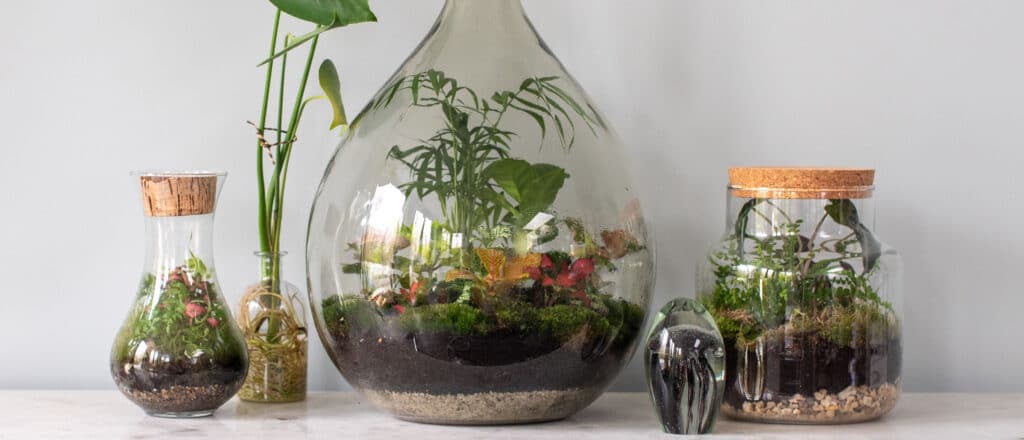

Here’s what you’ll need:
- A good potting mix (for this project we recommend Miracle-Gro® Cactus, Palm and Succulent Potting Mix)
- Activated Charcoal
- Your choice of terrarium-friendly plants: like succulents, air plants or miniature cacti
- Pebbles for drainage
- A spray bottle for watering
- Battery operated mini string lights
- A glass container for your terrarium plants
- Decorative or polished stones
- Crystals, small gnomes, or other mini decorations you want to add
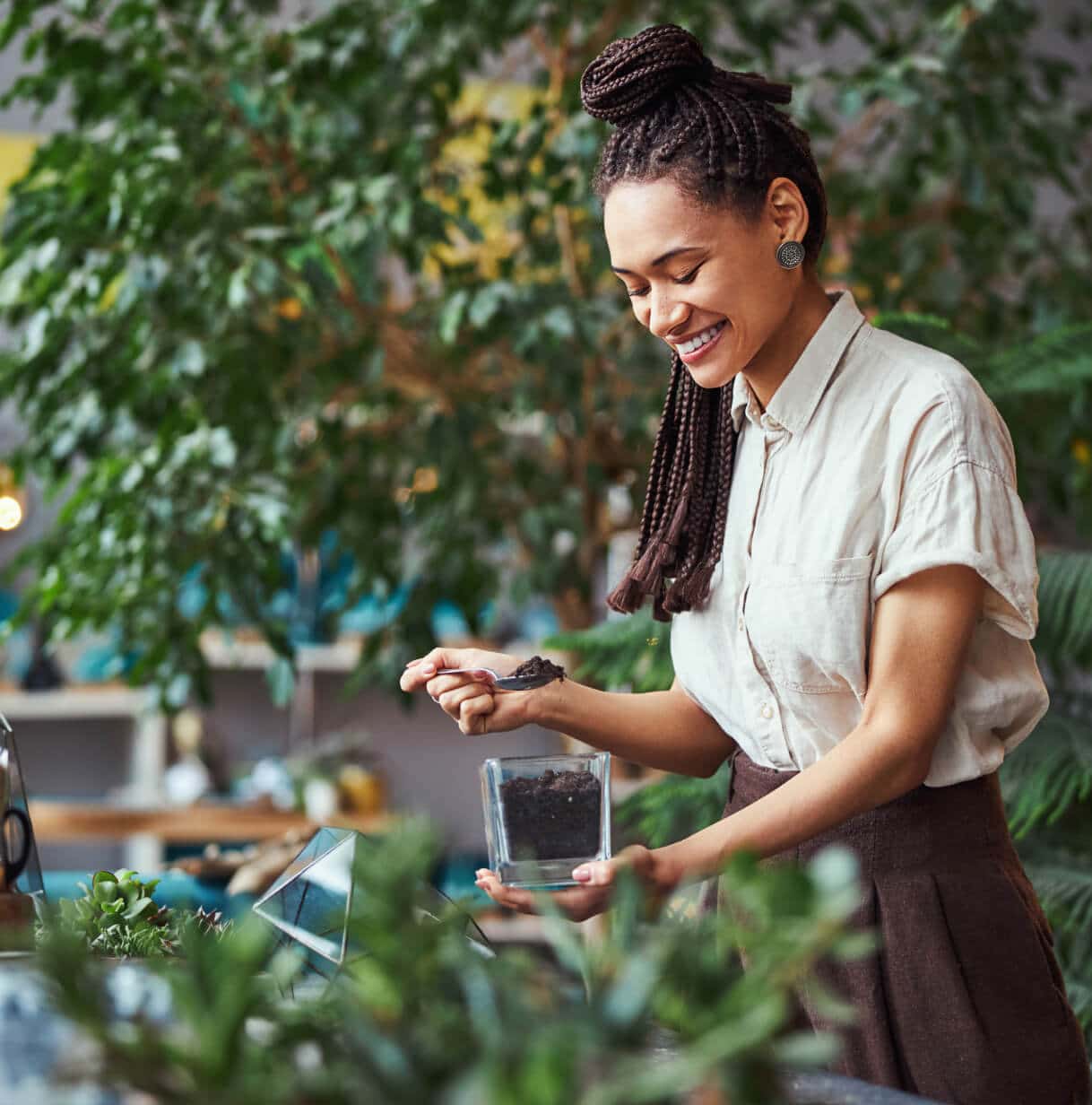
step 1: choose your terrarium “home”
Before you begin, think about the style of your terrarium and the type of plants you want to put in it.
The answers to these questions will determine whether you should opt for an open or closed terrarium.
If you want tropical plants that thrive in humid conditions, a closed terrarium is ideal. On the other hand, if you opt for small cacti or succulents, an open terrarium is the best solution.
step 2: build your base
Got your perfect terrarium container? Great! Now, the real fun begins.
Start by adding a 1-1.5 inch layer of pebbles, followed by a thin layer of charcoal. The pebbles act as drainage holes, while the charcoal helps reduce the amount of bad bacteria that might start developing as your plants grow.
Once you’re done, add about 2.5 inches of your potting mix. Make sure you have enough soil for your plants’ roots to fit.
step 3: add your plants
Remove your plants from their original pot. Gently massage their roots to get rid of excess soil, and create small holes in your terrarium for your plant roots before carefully placing them inside.
We recommend starting with the bigger plants
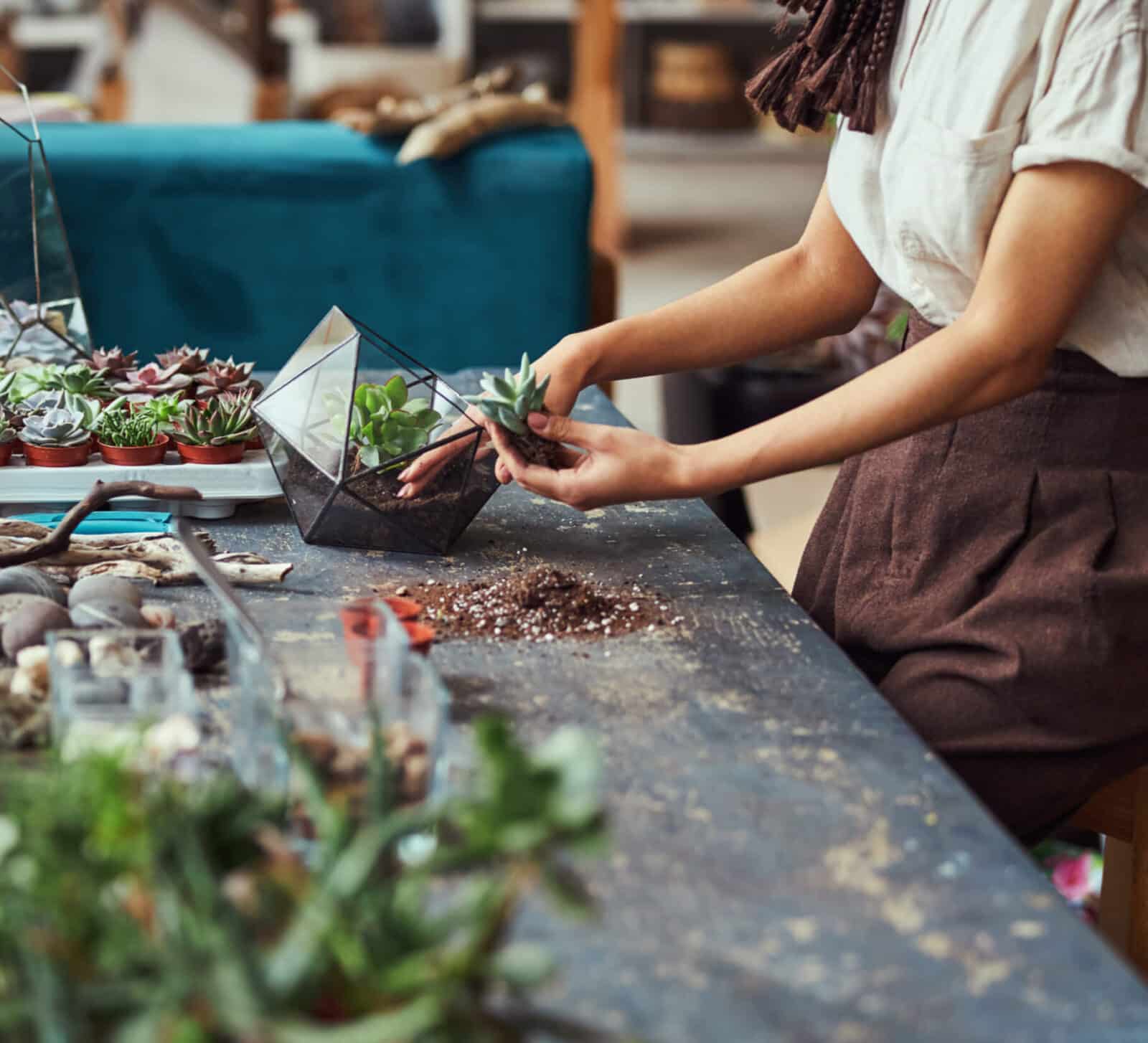
step 4: have fun with it!
Now comes the best part – decorating your terrarium.
You can add polished stones, crystals, small figurines, or any other miniature decorations to make your terrarium unique to you.
Bring out your inner child, and don’t hold back!
step 5: light it up
Carefully weave your string lights into your terrarium, making sure that they’re not getting in the way of your plants. Place your battery pack somewhere easily accessible.
Once you’re all done, turn on the lights – and watch your terrarium come to life.
Not only do string lights add a touch of mythical beauty to your creation, they also provide much needed artificial lighting to the plants inside.
step 6: feed your ecosystem
Terrariums need very little upkeep to stay alive and thriving. But the amount of water they require depends on the type of terrarium you have.
Water evaporates faster in open terrariums, so they typically require a few sprays of it every couple weeks. Closed terrariums, however, retain water for much longer, so you only need to water them about twice a year.
Congratulations – you’ve officially created your own little ecosystem! Enjoy watching and documenting the growth that happens within your terrarium, all while fielding countless compliments from your friends and family.
#happycreating!
It’s the most wonderful time of the year: seed starting season is upon us! Starting your own seeds is by far the most cost effective way to create a lush, bountiful veggie garden in your own backyard. Here are three different ways to start your seeds: one simple setup requiring little equipment, an intermediate setup with a Root Farm Grow Light, and an AeroGarden to really kickstart those seeds.
MiracleGro Seed Starting Potting Mix + Window
This is the simplest seed starting method. Basically requiring sunlight and soil, it is also the method that requires the least investment (sunlight is free!).
To start seeds using this method, you need:
- A sunny window to put your seeds
- Seed starting pots (can substitute for egg cartons or nursery pots)
- Seeds
- MiracleGro Seed Starting Potting Mix
- Plant labels (can use popsicle sticks)
- Permanent marker
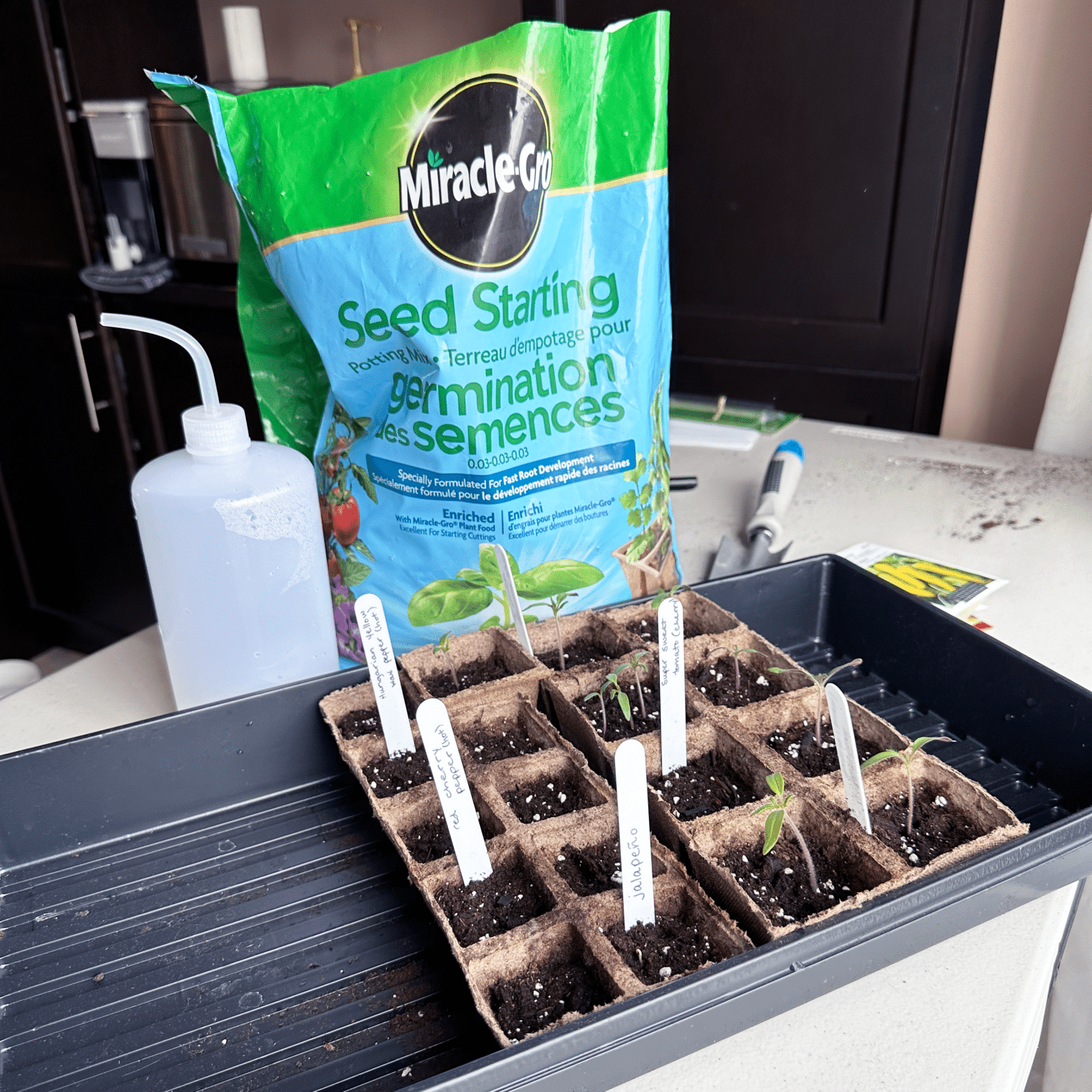
This seed starting setup is as simple as filling the pots with MiracleGro Seed Starting Potting Mix and placing a seed in each pot. Label the future seedlings with permanent marker on plant labels or popsicle sticks and place them on a sunny windowsill. Be sure to water them every day or two to keep the soil moist.
MiracleGro Seed Starting Potting Mix + Root Farm Grow Light
Starting seeds this way takes things up a notch by adding in a grow light. Grow lights are great because they give your plants a consistent source of light, regardless of whether the weather decides to cooperate. I love the Root Farm Grow Light because it’s large enough to fit a whole tray of seeds underneath, and it keeps the seeds on the warm side as well.
To start seeds using this method, you need:
- Root Farm Grow Light
- Seed starting pots (can substitute for egg cartons or nursery pots)
- Seeds
- MiracleGro Seed Starting Potting Mix
- Plant labels (can use popsicle sticks)
- Permanent marker
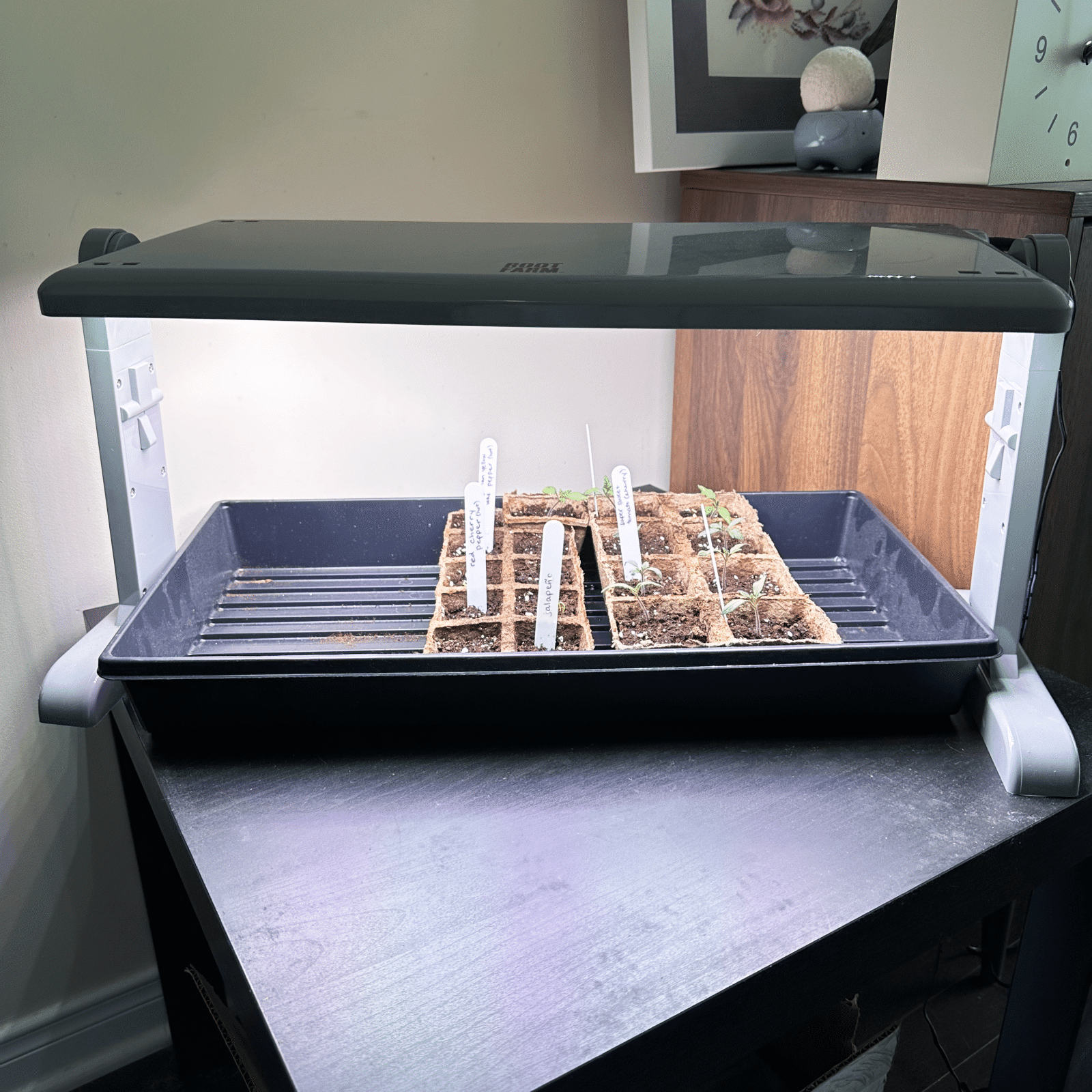
This seed starting setup is similar to the previous one. Begin by filling the pots with MiracleGro Seed Starting Potting Mix and placing a seed in each pot. Label your seedlings with permanent marker on plant labels or popsicle sticks. Assemble the Root Farm Grow Light and plug it in, placing it over the seeds. Water the seeds every one to two days to keep the soil moist.
Pro tip: Try plugging your Root Farm Grow Light into a smart plug. Use the app on your phone to set a schedule so you don’t have to worry about turning it on and off every day!
AeroGarden Seed Starting System
Of these three methods, the fastest way to get your seeds to germinate is, without a doubt, the AeroGarden Seed Starting System. AeroGarden is a hydroponic growing system for 5x faster growth than soil. The AeroGarden Seed Starting System is an accessory that is sold separately from the AeroGarden, and is available for the various models (be sure to choose the Seed Starting System made specifically for your AeroGarden model.)
To start seeds with the AeroGarden Seed Starting System, you’ll need:
- AeroGarden (Harvest Elite is pictured, but you can use any model)
- AeroGarden Seed Starting System accessory (Harvest Elite is pictured; choose the version made for your AeroGarden model)
- Seeds
- Water
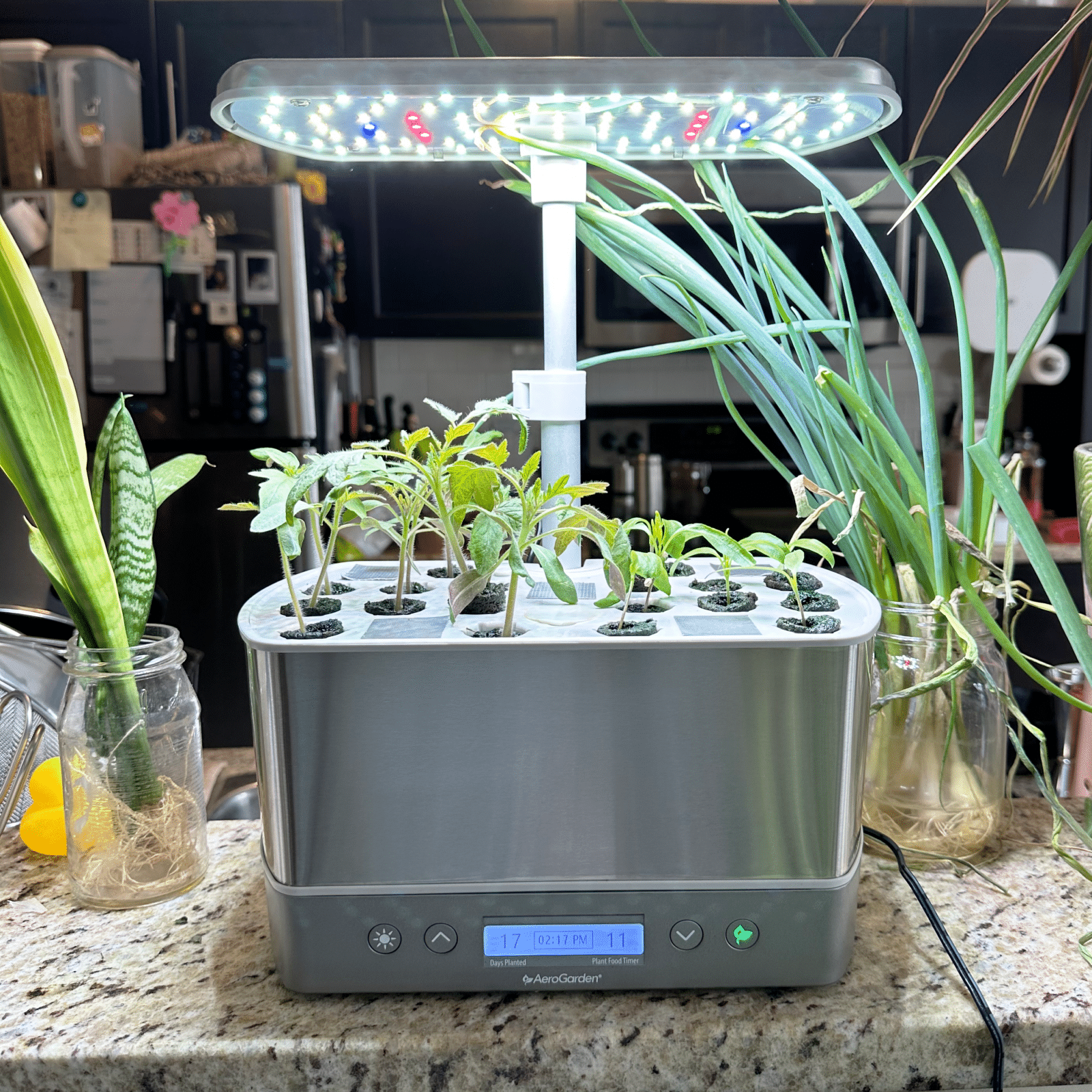
Begin by pre-soaking the grow sponges in water. Swap the standard AeroGarden grow deck for the Seed Starting System grow deck and place one sponge in each of the holes. Place a seed in each of the grow sponges. Plug the AeroGarden in and go follow the steps to start a garden. Fill the reservoir with water and plant food (according to directions on the back of the bottle).
Pro tip: To “label” your seedlings, draw a diagram of the AeroGarden grow deck (or take a photo with a smartphone) and label each space according to which seed you planted where.
For more advice and ideas on Aerogardens, visit www.aerogarden.com.
#easypeasy
Recently, we asked our Instagram community what their biggest questions were when it comes to repotting.
The response we saw, again and again: “When is the right time to repot my plant?”
We understand the confusion. Knowing when a plant needs to be repotted isn’t the same as knowing when you should get a bigger pair of jeans. There’s more nuance and complexity to the decision.
Which is why we put together a handy-dandy checklist to help you figure out if your plant needs a bigger pot, or not.
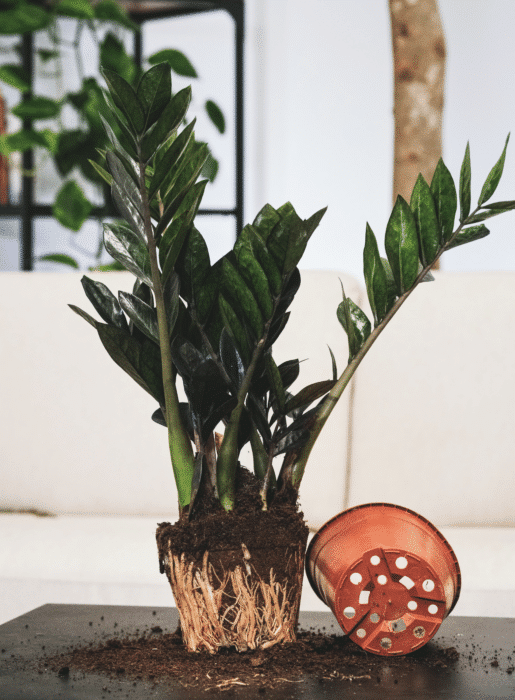
1. are your roots growing out of their drainage holes
If so, it’s a clear sign that they have no more room to grow in their current planter, and need a larger one, ASAP.
2. Are you seeing plant roots on the surface of your soil?
When they’ve run out of space, roots can begin to grow upward in search of more soil and nutrients. This can push the plant up, and make it look like it’s almost coming out of its pot.
3. Is your plant growing slower than usual?
Yes, winter dormancy is a thing. But if you’re noticing a significant lack of growth, this could be a sign that your plants simply don’t have enough space to continue thriving.
4. Is your plant slumping over?
Once your plant has grown larger than its own pot, it’s likely to start tipping over. Which is when you know you need a bigger, wider pot to help it maintain stability as it grows.
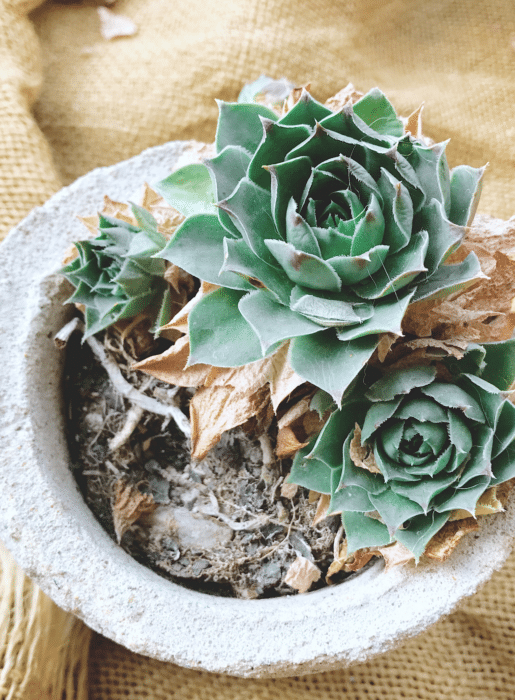
5. Does your potting mix dry faster than usual?
Growing plants have a need for extra nutrients and water. So if you’re noticing their soil getting dry faster, that means it’s time to transition to a pot that will facilitate your plant’s steady growth.
6. is your plant more than 3X the size of its current planter?
Ideally, your pot should be half the size of your plant. If your plant becomes triple its size or more, it needs extra space – or else its growth will be inhibited.
7. is there a weird white residue on your pot or plant leaves?
That’s salt and mineral buildup – which is a clear indication that your plant needs more nutrients, and potentially a bigger pot with fresh soil.
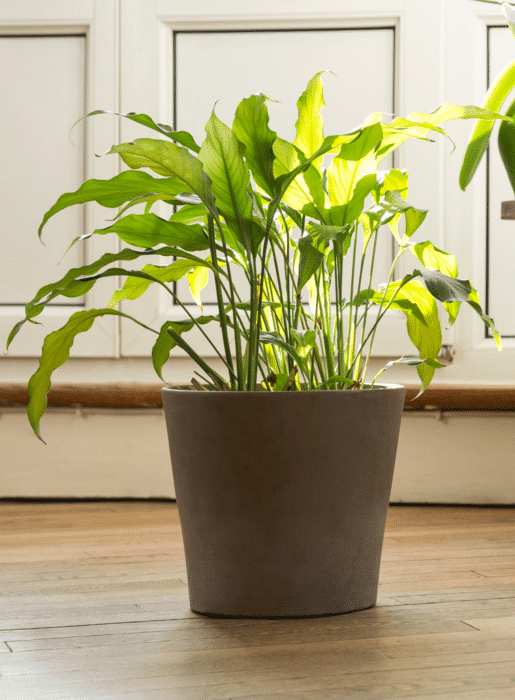
8.has it been over a year since you last repotted your plant?
Rule of thumb: repot your plant at least once every year! It’ll spur new growth, and keep your plant healthy and happy.
to drain or not to drain
It is recommended selecting planters and pots with drainage, especially if you are new to watering plants. It’s totally possible to make planters without drainage work with a little finesse! A good tip to remember is to pour no more than 1/3 of the container’s size in water. Lining the bottom of a planter with lava rocks or similar to create crevices for excess water to drain into is a great way to avoid root rot.
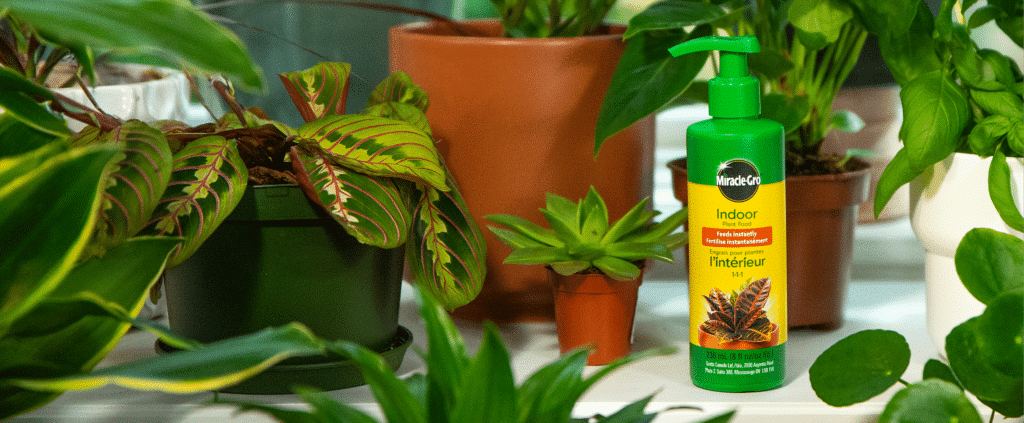
what you’ll need
- Your plant (obviously!)
- Your new planter
- Miracle-Gro® Indoor Potting Mix
- Miracle-Gro® Indoor Plant Food
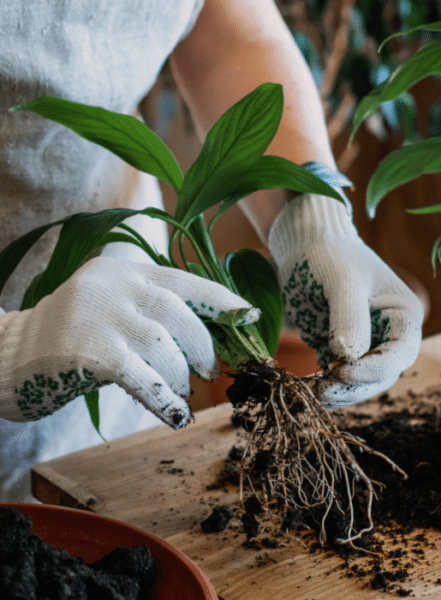
step 1: remove your plant from its current planter
Turn your plant sideways, hold it gently by its stems, and tap the bottom of its pot until the plant slides out.
step 2: prep your plant
Loosen your plant’s roots by massaging it gently with your fingers.
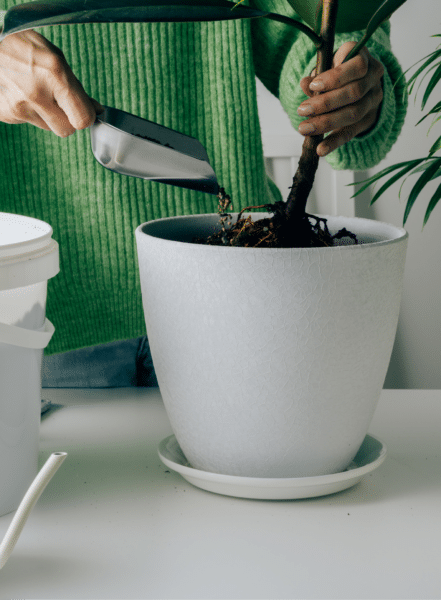
step 3: add your potting mix
Scoop in a nutrient-rich, well-draining potting mix into your new plant pot, until it fills a third of the pot. We recommend Miracle-Gro® Indoor Potting Mix – it feeds your plant for up to 6 months!
step 4: add your plant
Place your plant into the new pot, filling it in with more potting mix. Look at that – you’re only one step away from being done!
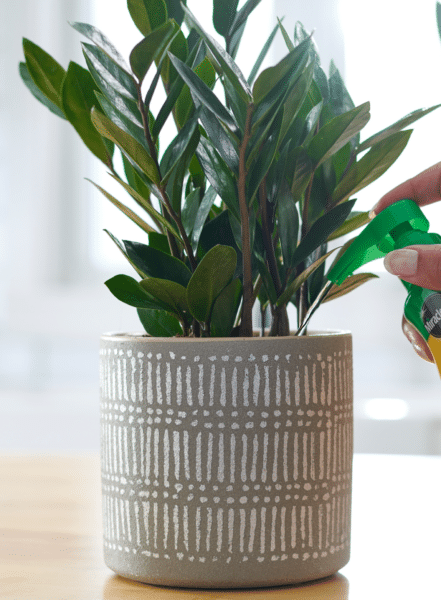
step 5: feed your plant
Give your plant a good watering, and add some Miracle-Gro® Indoor Plant Food for an extra nutrient boost.
Want more info where that came from?
To learn more about which material and size of planter you should be getting for your plant’s repotting, read this article!

